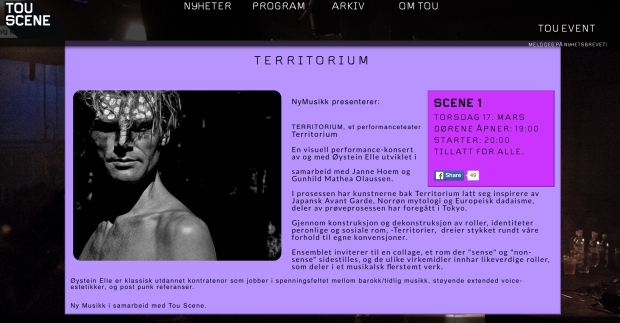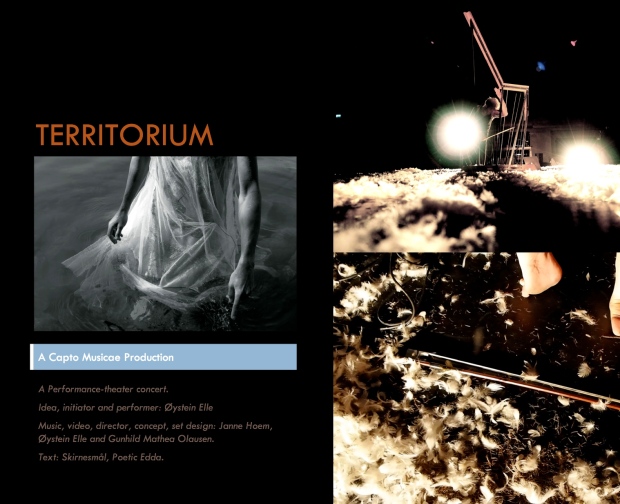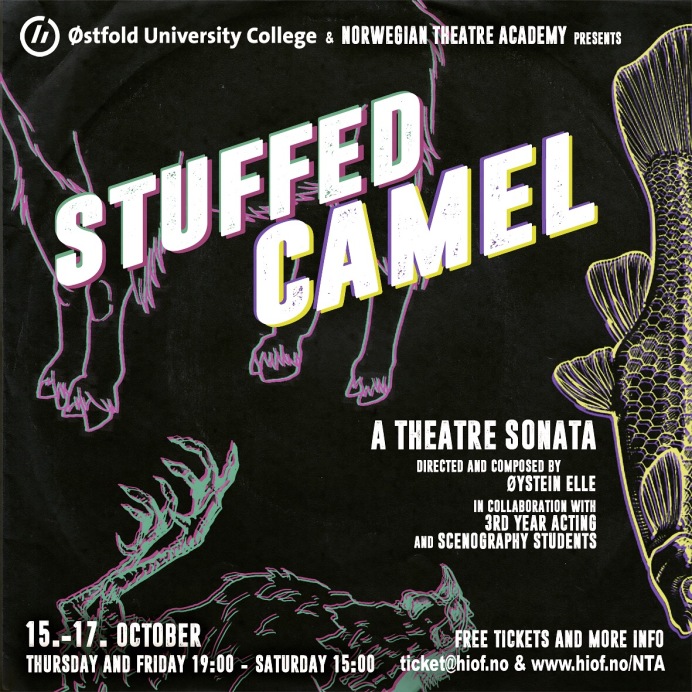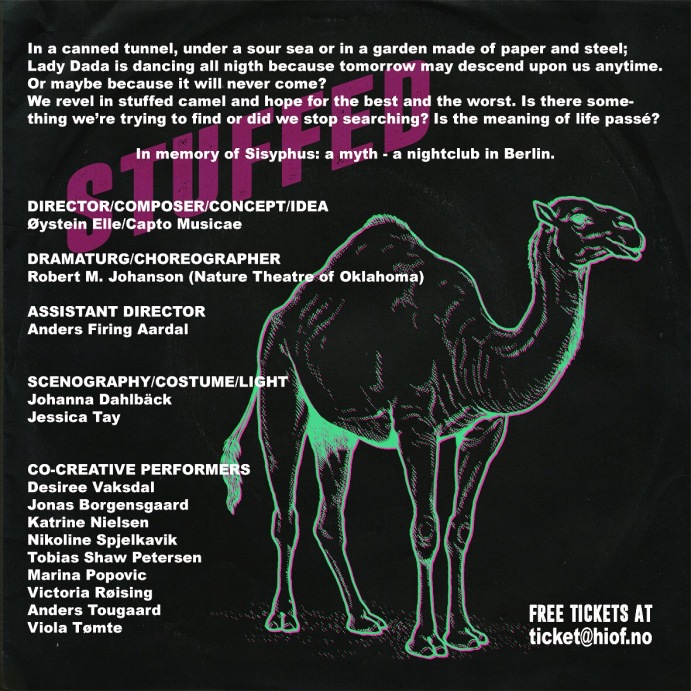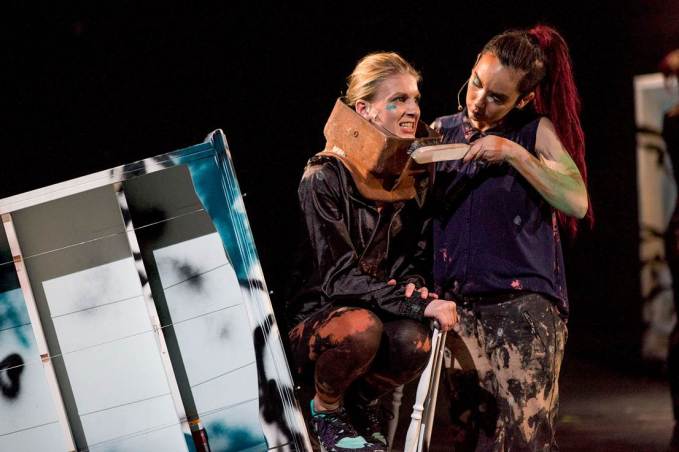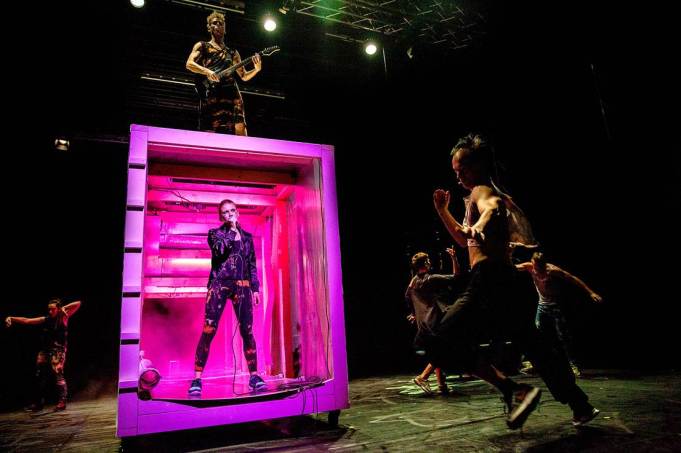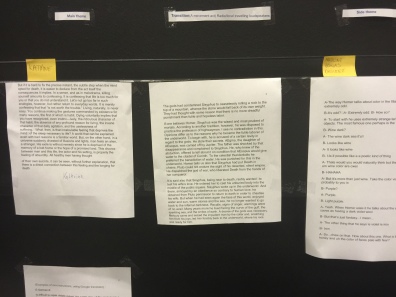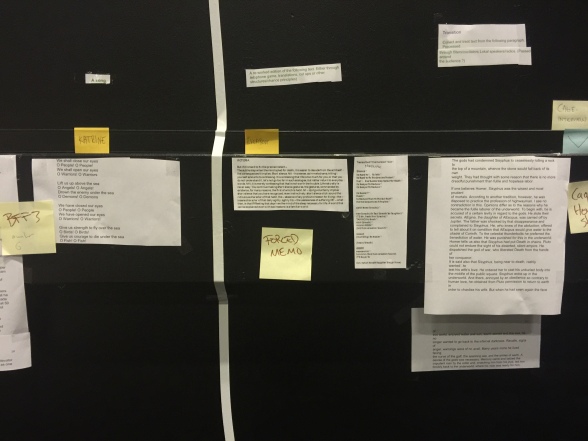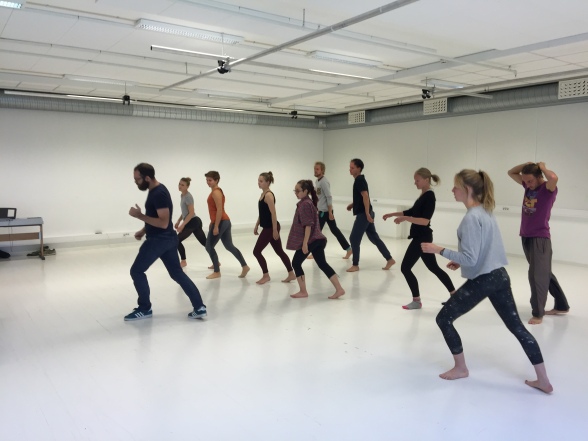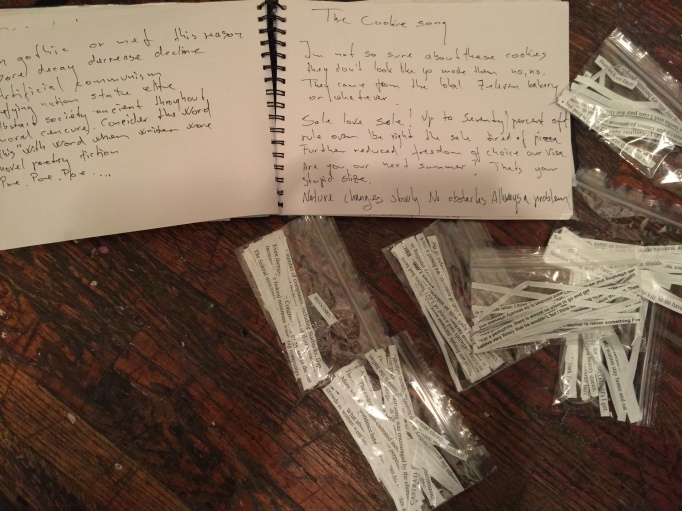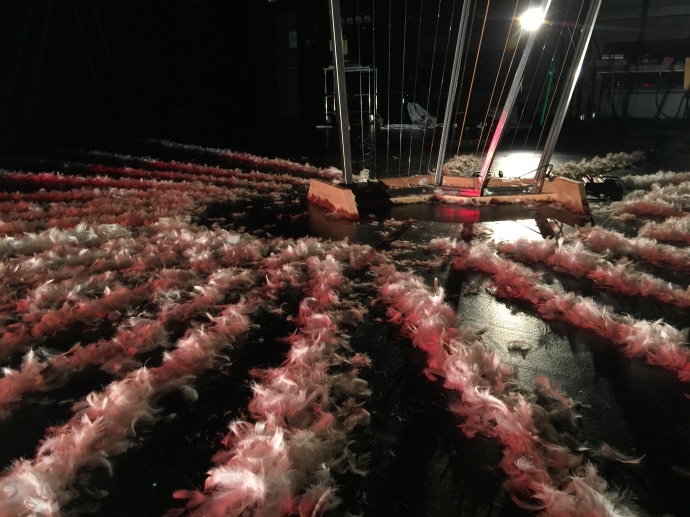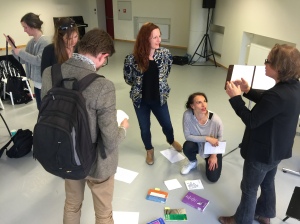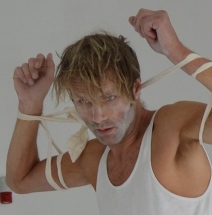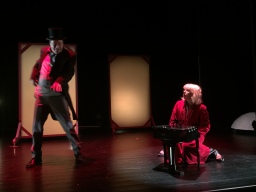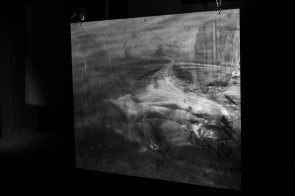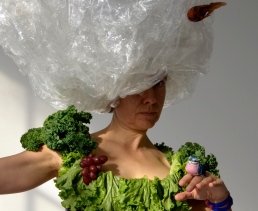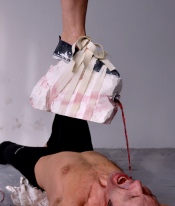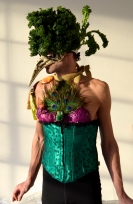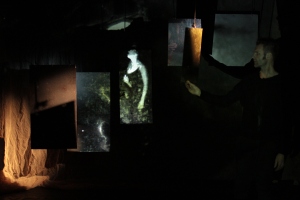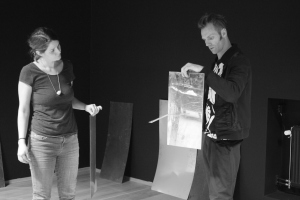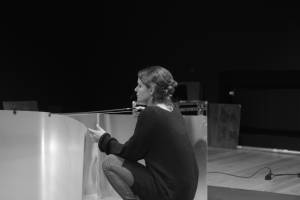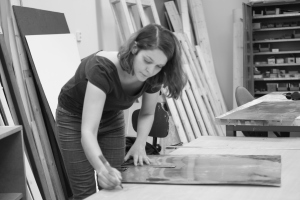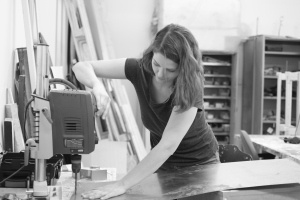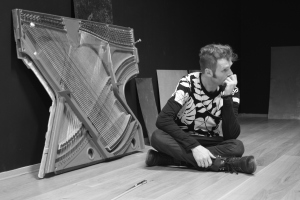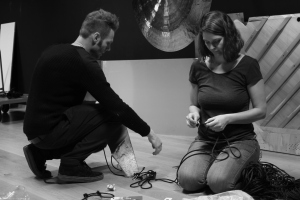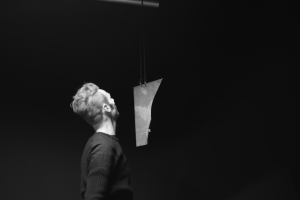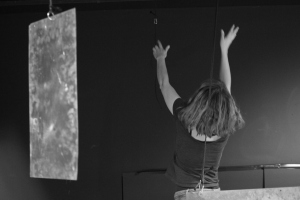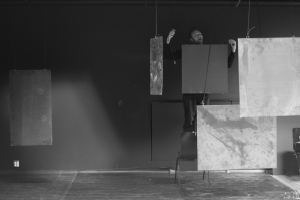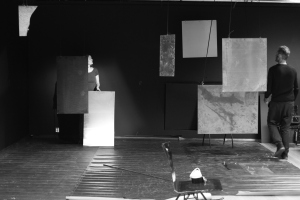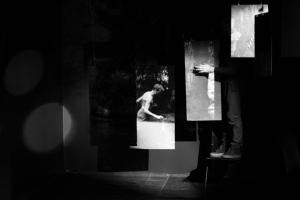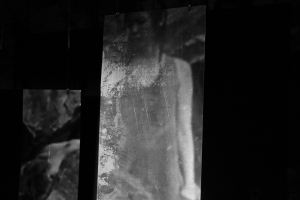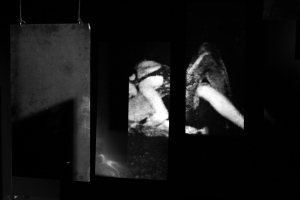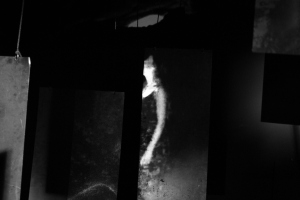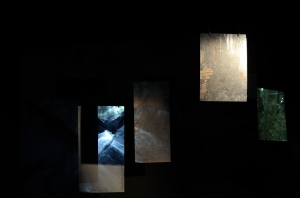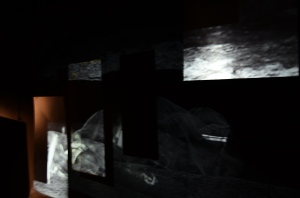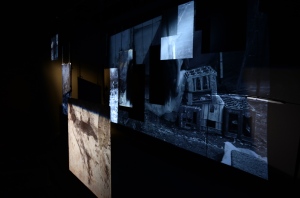Reflection and Documentation
CAPTO MUSICAE – CREATING SONIC AND MUSICAL THEATRE IN A CONTEMPORARY ARTISTIC CONTEXT
Øystein Elle
The National Norwegian Artistic Research Fellowship Programme 2013 – 2017
Norwegian Theatre Academy, Østfold University College
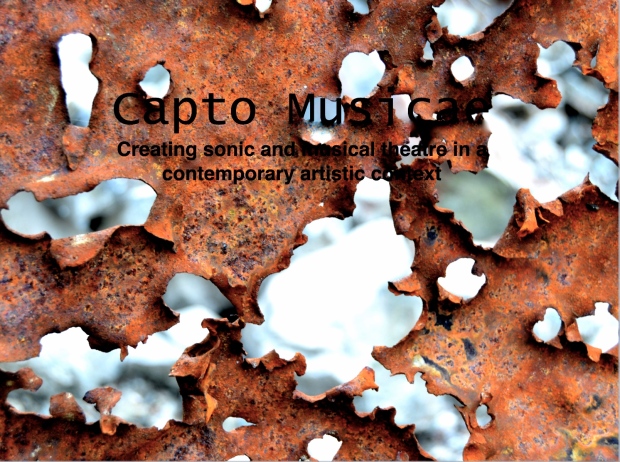
TABLE OF CONTENTS
PREFACE
ACKNOWLEDGEMENTS
ARTISTIC INTENTION
THE PROCESS
Text work
Collaboration
Composition
Extended vocal techniques
MAIN ARTISTIC RESULT
Territorium – A Visual Performance-Concert
Stuffed Camel – A Theatre Sonata
ADDITIONAL ARTISTIC OUTCOME
Chernobyl Stories
Decadence & Decay
CAPTO MUSICAE IN THE ARTISTIC FIELD
DOCUMENTATION OF THE MAIN ARTISTIC RESULT
Stuffed Camel – A Theatre Sonata
Territorium – A Visual Performance-Concert
REFERENCES
PREFACE
I am a singing performer, one who has spent quite some time to find my artistic and musical standpoint. Or rather, I should say viewpoint, since I am constantly seeking out new sources of inspiration.
In my youth I was very found of, and fascinated by, my soprano voice. When my voice naturally changed during puberty, and I gradually began to lose my highest registry, I did not reflect upon possible opportunities to preserve my soprano register. Later, while listening to the Passions and the Cantatas by Johan Sebastian Bach, one of my favorite composers, I discovered that some of the high-pitched soloist sections were sung by men. The voice I fooled around with, usually behind closed doors, could now perhaps attain a new status: as something other than merely the echo of a boy`s voice, or a dream of what used to be, or a desire to release my voice from gender normativity. At that time, early in my music studies at the conservatory, I learned that my voice had a word, which helped to set me free upon my quest: countertenor.
The phenomenon of men singing in a tonal range we in the western music tradition usually associate with women or children is clearly not new. For hundreds of years it was commonplace to perform surgery on young boys so that they would preserve their high bright voices into adulthood. As one scholar remarked recently: “The practice of castrating boys for their singing voices—what has been called aesthetic castration, or castration for the sake of art—dates back to church choirs in early medieval Constantinople and 12th-century Spain, although there have been eunuchs throughout history” (Koons 2015). The popularity of castrati as opera singers reached their zenith in the 17th and 18th century: the fame and fortune they might achieve made optimistic parents willing to surrender their sons into the care of shady establishments where castrating operations were performed. Annually, thousands of young boys were tortured in the service of their parents’ aspirations that their son would be the next superstar; a performer whose fortune´s glow would extend onto their surrounding family members, and thus ensuring wealth and security for all. In reality, however, most of these children died from these encroachments, and the survivors frequently faced a life of misery, ostracized from their own community. As of 13 April 2017, the New World Encyclopedia states on its website that castration was forbidden by law in Italy until as late as 1870.
While growing up, classical music and baroque music were just as much a part of me as heavy rock, punk, and glam rock. For my education I chose a classical musical path; at the time the mixing of genres was considered taboo in the consevatories. After rediscovering my high-pitched voice during my traditional conservatory training, I started specializing in baroque music, where I found room for spontaneity, improvisation, and a truly playful approach to music research and performance. This, in combination with the expansion of the timbral possibilities of voice implicit in my development as a countertenor, began my attraction towards what I later learned were extended vocal techniques.
As a child I had a favorite word, one I would repeat over and over again. I would say it aloud, exploring every sound within it; I would whisper it; I would even think it, imagining the vibratory and physical sensations when I pronounced the word. The word was eple–the Norwegian word for apple. Another early memory, equally strong as eple, was the duet of voices I heard daily inside my head until approximately age 14. These two voices were always in contrast to each other: one was low, rather soft, always speaking slowly; while the other was hectic and high-pitched. Both spoke an unknown language, yet their “words” somehow made sense to me, on a deeper level. Since this time, I have been drawn to experiencing words and text as something far more complex than mere units, parts of a language whose sole purpose is understanding. Instead, for me words are sonic events in of themselves, detached from their linguistic meaning. As for vocality, I am drawn to ideas of liberating the human voice´s timbre from being pigeonholed according to gender or age. This summary of some of my motivations ultimately led me to a range of artistic movements and traditions, including: Dadaism, Surrealism, experimental literature, sound poems; the aforementioned term of extended vocal techniques; and subsequent avant-garde directions.
These three years with Capto Musicae have provided me with many resources to create a new artistic process. I have collaborated with local and international artists, weaving together multiple perspectives towards common creative milestones and generating fresh performance material. I have been given the opportunity to advise, teach and collaborate with art students, including students from the Norwegian Theatre Academy and the The Danish National School of Performing Arts. Through the broad international network of artists connected to the Norwegian Theatre Academy (NTA), already-existing partnerships have deepened, and new collaborations have been established. These meetings, discussions, collaborations, and suggestions have all guided me towards uncovering new insights into my work as a vocal / theater artist–explicitly from numerous artists and scholars in the field, and implicitly from sources which live on through their artistic heritage, and the ability to continuously inspire new generations. The process of Capto Musicae has connected my own artistic orientation more strongly to historical traditions as well as to new, progressive artists of today. I link my research to a broad tradition of artists who alter the position of semantic meaning in texts, and whose musical ideas–as the American composer Daniel Goode puts it–“steal musical technique away from the medieval power-center of the Conservatory” (Goode 2011).
I feel I now have a newfound ability to continually find inspiration. Through adversity and prosperity, the sum of these three years have been crucial in my personal and artistic development.
ACKNOWLEDGMENTS
My deep gratitude to Professor Karmenlara Ely and Professor Claire MacDonald, my research supervisors, for their patient guidance, enthusiastic encouragement, and useful critiques of this artistic research work.
Also, my tremendous appreciation to all of the inspiring advisors, artists, colleagues, and friends who I have had the great pleasure to invite into this process: Phil Minton, Kristin Norderval, Pauline Oliveros, Linda Wise, Yoshito Ohno, Misako Ueda, Mina Mizohata, Camilla Eeg Tverbakk, Sxip Shirey, Jill Sigman, DJ Joro Boro, Heloise Gold, IONE, Jan Skomakerstuen, Ruth Wilhelmine Meyer, Janne Hoem, Robert M. Johanson, Corentin JPM Leven, Nils Henrik Asheim, Birgitte Fjeld Bjørsvik, Karianne Bjerkestrand, Lars Øyno, Brendan McCall, Seshen, Neiro, Mutsumi, Bjørnar Mæland, Johanna Dahlbäck, Anders Firing Aardal, Victoria F.S.Røising, Nikoline Spjelkavik, Viola Tømte, Anders Tougaard, Jonas Borgensgaard, Marina Popovic, Desiree B.Vaksdal, Katrine Leth Nielsen, Tobias Shaw Petersen, Ulf Knudsen, Patricia Canellis, Henriette Slorer Jakobsen, Tim Finset, Anne Berit Løland, Unni Anita Skauen, Agnes Smid, VoxLab, the Colleges at the Norwegian Theatre Academy/Østfold University College, Artistic Research fellows, board and staff at the National Artistic Research Programme, the Staff at Theatre Xcai (Tokyo, Japan), the Staff at Tou Scene (Stavanger), NyMusikk (Stavanger), Fund for performing artist, the Norwegian Arts council.
And last, but definitely not least, a heartfelt thank you to my patient and supportive wife, and our lovely daughters Maren, Tora, Eivor and Hulda.
ARTISTIC INTENTION
Through the project Capto Musicae (Latin, meaning to catch or to capture music) I am exploring new possibilities for music-theatre at the intersection between concerts, performance art, visual art, and theatre, using the compositional tool of extended vocal practice as the primary framework. Through the creation of my own work, I seek to research and develop methods in which texts and sounds may come together as equals with the spatial, visual, and kinetic elements inherent to live performance. Ultimately, I aim for creating theatre through a musical re-organization of all the theatrical elements.
The context of this artistic research is historically grounded in the baroque, both in terms of musical and as well as visual aesthetics; in twentieth-century Western avant-garde; in experimental approaches to the voice in performance; as well as the singing voice within the musical genres of heavy rock, post-punk, and noise. Capto Musicae operates as a dialogue between music and theatre; the project works with, as well as responds to, the histories of both disciplines. My methodology is situated in theatre, moving equally between this and music. As a theatre-maker, I approach performance musically: through the eyes (and ears) of a composer/performer/singer; theatrical elements play equal parts within its larger, compositional or musical whole, just like the parts in a polyphonic or homophonic musical work. This method is in alignment with how the German theatre researcher Hans-Thies Lehman describes Robert Wilson´s staging of Hamlet: “As a neo-lyrical theatre that understands the scene as a site of an ‘écriture’ in which all components of the theatre become letters in a poetic ‘text’” (Lehman 2006, page 58). My approach is connected to the “musicalization” of theatre–one of the characteristics of post-dramatic theatre, according to Lehman.
The sound of objects (such as the scenography, as well as properties or “props” handled by the performers) onstage is as important to me as any other practical and/or visual function they might have. When composing for a theatrical performance, I aim to develop music in the theatre, from the inside-out, and in collaboration with the performing ensemble. I want to be as close to the range of diverse material in which the performance is built as I can, and do so as early as possible in the process. I often prefer to create within a trans-disciplinary fashion: to let the music emerge through the various disciplines, letting it mold in relation to the various spatial, visual, textual, and kinetic elements made by all of the collaborators. When working on a project, I am constantly adjusting and altering the musical score to suit the evolving performance. The diversity of artistic skills, personalities, bodies, materials, and architecture found in the production directly informs the musical score I ultimately compose.
As a tool for composition within my work, I often utilize extended vocal techniques in conjunction with what might be called “extended text work”, a means of re-working the text used in performance. I am exploring the boundaries between interpretation and re-composition of existing textual material, in combination with new written material. In order to recompose material, I am mixing traditional chance methods, with new developed methods, and experiments with technological methods.
My research asks what a musical adaption of the linguistic sounds can give to the narrative, the understanding and the experience of text. I am asking if an aural, abstract treatment of text might illuminate and give a deeper understanding beyond the immediate cognition. I research a combination of an extended use of textual material with a sonically extended approach to the voice. I am chasing a rootless vocal sound that picks up from the traces, debris of lingual sounds, words and crumbles of words, melodic fragments and textures; an inaccurate sweep through history of diverse traditions and cultures. I collect sonic characteristics, sounds, phrases textures and linguistic sounds. I add them to my collection of sounds, and process them for use in new constellations.
By extended text–or re-worked texts–I am talking about texts composed to provide a different or additional function to the linguistic or the semantic, such as the visual poem “Fishes Nachtgesang” by Christian Morgenstern, which I will describe in the chapter “The Process”. I am also referring to texts that are altered or re-composed, with or without elements of chance. Significant examples of this process include the cut-up techniques developed in the 1960s by William S. Burroughs and Brion Gysin. During a 1966 interview with Conrad Knickerbocker, Burroughs details some of his methods.
INTERVIEWER: What do cut-ups offer the reader that conventional narrative doesn´t? BURROUGHS: Any narrative passage or any passage, say, of poetic images is subject to any number of variations, all of which may be interesting and valid in their own right. A page of Rimbaud cut up and rearranged will give you quite new images. Rimbaud images–real Rimbaud images–but new ones (Plimpton 1967).
While the extended text in my experience may open up for a broader and more real perception of a theatrical art piece, I believe that the extended vocal techniques point towards a truer expression of humanity. The human voice is capable of producing a broad range of sounds, and one must assume that the sounds a human can produce without technological resources are therefore natural sounds. Sounds that express fear, joy, wonder, desire, disdain, and rage. An infant can cry for hours without getting hoarse; and while joyously playing, or in despair and pain, the child can express a wealth of timbres and textures. An expression register, and a tonal register, that we in our Western tradition may seem to grind down over time, minimized by social norms, not at least gender norms, and other restrictions related to upbringing. Within the western tradition of singing training the voice is being developed in a stylized direction, most often far removed from the primitive sounds, or sounds that in itself to a significant degree express emotions. “Instead of endeavoring to develop the ideal ‘specialized voice’ ” Amy Rome asserts in her thesis that “Wolfsohn’s[1] inclusive approach to voice training sought to reveal the human voice ‘capable of expressing the human condition’ claiming ‘all I am doing is going back to nature’” (Rome 2007). This technique and aesthetics provides opportunities to work with the voice as a performative instrument in and of itself, a carrier of sonic and musical material that goes beyond the gender-specific, as well as outside the conventions related to the terms “singing” or “speaking”. The sounding voice, and the music that arises, may now become the action itself, rather than being merely accompaniment.
Through Capto Musicae my goal is to create music-theatre performances and exercises which can draw on the history of the human voice and on the rich legacy of music from various traditions. By replaying and rethinking, and by gathering vocal-aesthetics and linguistic data, picking up traces and debris, I am seeking a musical/sonic language and voice that derives from a rootless sweep through time and space. That is, I collect vocal sounds from a wide range of historical and cultural traditions, such as ancient chants, throat singing, western heavy rock, Arabic singing, and many more.
The experimental tradition, including the work of John Cage, Meredith Monk, Christian Wolff, Heiner Goebbels, Peter Maxwell Davies, Luciano Berio and others, expand the possibilities of sound in performance art. Further, alongside baroque, punk and Dadaism, these lineages compose a crucial background in how I am seeking to extend the range of vocal ideas and techniques in my research. I am asking: How can we work from the established experimental tradition towards creating new music theatre and music-driven performance for the 21st century?
The term Postdramatic theatre, introduced by the German theatre researcher Hans-Thies Lehman, has been widely used amongst practitioners and theorists in the field of theatre since it first was coined in his book “Postdramatic Theatre” (1999), and even more widely after the English edition (2006). As Marwin Carlson points out, “Probably no critical term since theatre of the absurd has proven as attractive to theatre theorists as postdramatic theatre” (Carlson 2015.) Later, Carlson says that “Almost any critical term, especially in recent times, a major price paid for popularity has been wide application of the term, to the point that anything like a coherent and consistent definition of the term has become quite impossible” (Carlson 2015.)
One could argue that my artistic voice is situated within this vast, contradictory, hard-to-define field of postdramatic theater, first with reference to musicalization. According to Lynn and Roesner, musicalization should not only be understood as merely a replacement of the traditional system of securing coherence in a theatre performance in favor of another system; in other words, replacing the system of language, character, and narration, with another system–that of rhythm, melody, and form. Rather, Lynn and Roesner state that the musicalization of theater suggests “A shift of emphasis of how meaning is created (and veiled) and how the spectrum of theatrical creation and reception is widened” (Lynn and Roesner 2011).
Perhaps more specifically my work connects to another term: Composed Theatre (Rebsstock/Roesner 2012). Roesner states that this terms refers to a growing interest in the idea of “approaching the theatrical stage and its means of expression as musical material” (Rebsstock/Roesner 2012), as it has been done since the beginning of the twentieth century among composers such as Shoenberg, Cage, Kagel, Aperghis, Seither, Goebbels, and many more. Roesner continues by illustrating two different approaches to Composed Theatre. The first is where composers, directors, and theatre-collectives have an increasing interest in postdramatic forms of theatre: not emphasizing text-based dramaturgy, but instead seek alternative dramaturgic structures, such as visual, spatial, temporal, or musical. The second, originating from the field of contemporary music performance and composition, is the ever growing range of elements in use such as light, sound, bodily movement, video, live electronics and more in creating a greater theatrical orientation among composers and musicians (Rebstock/Roesner 2012). “Thus the interest in the musicality of theatrical performance and the theatricality of musical performance have given rise to a wide range of forms of what we propose to call Composed Theatre” (Rebstock/Roesner 2012).
In this reflection and documentation paper I plan to open up my artistic process in Capto Musicae, elucidating some of the key methods I have made utilized, borrowed, developed, or invented. In particular, I will unpack the process of developing, rehearsing and performing two of my music-driven theatrical pieces: “Stuffed Camel – A Theatre Sonata,” and “Territorium – A Visual Performance-concert”. Further, I will show examples of additional artistic works, performances, works-in-progress and sketches, achievements, mistakes, and failures experienced during the fellowship period. My practice is my methodology of inquiry.
[1] Alfred Wolfsohn (1896-1962), a German singing teacher, was a significant pioneer of what are now referred to as extended vocal techniques.
THE PROCESS
I am a practitioner in the field of music and theater. I test methods, I construct concepts, I compose. I practice instruments and vocal sounds, and am constantly working towards an expansion of my range of artistic expression. In the following pages I will attempt to verbalize my practice through the transverse axis between intention, process, and result. The intention, as described in the preceding chapter, will be discussed through this chapter on the process. Reflection upon my methods is embedded here, as well as within the various chapters which follow. I will discuss what were my artistic results; attempt to articulate the knowledge and discoveries acquired through my artistic work; and more specifically, through the artistic research process as a whole. Capto Musicae manifests within the artistic results.
Text work
Rather than emphasizing one narrative, or seeking to clarify a singular meaning, I seek diversity. I strive to find means to create a co-existence of voices and metaphors, of known and unknown languages. I am interested in fragments of stories, with performance texts which can diverge and even contradict or confront. In this way, I hope to own the meaning constructed in the situation–to become a reader among readers.
Theoretically, this notion draws from Russian philosopher and literary theorist Mikhail Bakthin. Referring to Bakthin´s notion of “Heteroglossia,” Nesari states that
Every meaning present inside a speech or a text arises in a social context in which a number of opposing meanings are present and develops its social meaning from its relationships with those alternative meanings. So texts are heteroglossic in the sense that they implicitly or explicitly acknowledge the presence of a definite collection of convergent and divergent socio-semiotic realities. So as a result every meaning within a text happens in a social situation in which a number of opposing meaning could have been made and this text derives its social meaning from the degree of opposition with those alternative meanings (Nesari 2015).
He goes on to say that “In dialogism there is always room for arguing since questions show everybody’s point of view rather than the universal truth. According to Bakhtin every human being likes to resist, confront and make personal meaning out of social interactions. So Bakhtin emphasizes the individual personality inside every cultural group instead of searching for unanimous agreement” (Nesari 2015).
Dialogue–the construction of meaning happening in the place between different voices (text) on one side, and the receiver on the other, may thus be described through Bakhtin`s theory. Reflecting on Dostoevsky´s dialectic, Bakhtin argues
It is constructed not as the whole of a single consciousness, absorbing other consciousnesses as objects into itself, but as a whole formed by the interaction of several consciousnesses, none of which entirely becomes an object for the other; this interaction provides no support for the viewer who would objectify an entire event according to some ordinary monologic category (thematically, lyrically or cognitively)- and this consequently makes the viewer also a participant (Bakhtin 1984).
The academic and intellectual context for my research combines philosophical and aesthetic approaches, which might be described as un-grounding the voice. The sonically and linguistically nomadic rootless voice that picks and works with the traces of the past is a source to create unknown and infinite possibilities.
Traditionally the term musicalize was understood as making a play into a form of music- theater, or making a text into a song. Helene Varopoulou (1998) as cited by Verstraete (2009) uses the notion musicalize to describe music as an independent theatrical structure that gives rise to the metaphor of ‘theater as music’ , beyond the evident use of music in theatre or music theatre.
Theatre scholar Dr. Pieter Verstraete, in his thesis “The Frequency of Imagination”, discusses musicalization in post-dramatic theatre as when
…the development of the events no longer drives to one focal point or goal (like, for instance, a climax or catharsis). Rather, musicalisation gives rise to fragmentation, ambiguity, and excess that urges the listener to make meaningful connections her or himself subjectively. And he goes on saying: “It is an indirect narration, produced by the process of narrativisation in the spectator’s mind. Narrativisation offers a way to structure and connect the experiences. It appeals to the human urge to interpret and make sense of the fragmentary perceptions (Verstraete 2009).
In my work, the musicalization of text in a theatrical performance refers not least to how the text is being read and experienced, but also how it approaches the receiver. By emphasizing other aspects than the narrative of the text, or the semantic meaning of the words, I attempt to let the text expand its purposes into also becoming rhythmic and sonic material in the overall composition.
In addition to the sonic qualities of a musicalized text, I am also interested in what meanings are created between these two creative subjects, the performer and the audience member, when they meet during a performance. Most people are used to searching for meaning in words. Hearing sounds that are believed to be a language, therefore, a recipient will often try to interpret the characters given to create meaning. According to Wittgenstein the use of language is a social activity, a language-game that requires an understanding of agreed-upon rules. As referred to in www3lokus.no, accessed on 17 May 2017, Witgenstein states that “Rules are social, because the rules are something we have tacitly agreed. The rules have no independent existence, but exist on the basis of the behavioral patterns we follow in our language games. The rules are shaped by what we do in our life world. Meaning is therefore in itself social.”
When textual material is transmitted from a sender to a receiver, a creation of meaning will often occur. A reconstructed text–such as a user manual for a toaster–processed through a method I’ve named Unruly speech to text misunderstandings–could be given a completely new meaning in a mutual negotiation encounter between the two subjects, the sender and the receiver.
Regarding Wilson´s view of textual perception and production of meaning :
The texts should not be thought of as providing a locus of meaning or interpretation, for in Wilson’s view of the theatrical experience, the actors, authors, director, and audience are all engaged in a process of assimilating and making sense of the production. As Wilson confesses, ‘We don´t try to say what it is or what it means. So we´re all the same from that point of view. Our theatre is an open-ended form, and the audience has the responsibility to bring an open mind (Kimbrough 2002).
I am interested in the spectator, the reader of the material as an active subject creating meaning when encountering the signs, the sound, textual passages and fragments. In my (composed) theatre work Territorium I am constructing parts of the musical and textual score from inner visions and subconscious material. As such, these elements could be labeled surrealistic. According to Lehman:
The Surrealist idea that a mutual inspiration takes place when the fantasies fed by the unconscious reach the unconscious of the recipient emphasizes a trait that is also of importance to the new ‘Theatre of Situation’ (the mutual inspiration of stage and audience) and the ‘Environmental Theatre’.
Aural treatment, and/or abstractions of text may be done by a number of methods, and is being done in various fields. I am later coming back to concrete examples of this in my research. Gomringer´s 1954 poem “Silencio” is a pertinent example:
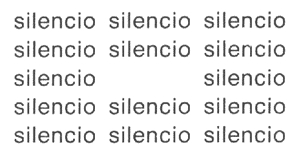
This text is from the field of visual poetry, or concrete poetry. I experience it as a strong example on how an abstraction, the action of removing a word, or the word is leaving space for the reader to aurally sense and create the content. Thus, the aural treatment facilitated by the poet, and performed by the reader is changing, and adding to the perception of the word, opening it up to associations and materializing.
Further I ask what a musical adaption of linguistic sounds can add to the understanding and the experience of text? I want to elucidate some aspects of text in performance by comparing text and music and discussing how texts have been, or can be, interpreted sonically in performance.
I am a singing performer—not just a singer, if anyone ever is. That is, I am someone who takes the signs that other people produce—sounds, written words, images, gestures—and then responds to them, changes them, re-creates them in new contexts, as part of a long tradition of experimenting with the production of meaning through performance.
I often detach letters and words from their lingual and narrative function, seeing them as building blocks with individual qualities. I utilize both of these approaches, along with game structures, in my textual reconstructions, and thus bring a linguistic chance element into the work that may or may not add elements of meaning. When I process textual material, and adding chance elements like text machines and game structures, I experience that the text are being highlighted, and that it opens itself to me as a reader, rather than it being obscured. Rather than attempting to give me as accurate as possible the thoughts of the author, following the same narrative track, a reworked text might open up new connections, add stories, visions, create ideas and meaning far more complex that the original text configuration probably would be able to. What if we see the original text simply as a starting point for all kinds of ways of responding, ways that radically change the original, add to it, clarify it, or make it more meaningful.
If we assume that the text is what is written down, then the sonic treatment has an executive function. After having retrieved information from the written characters, this information is reinterpreted, and then sent out as sounding-language. The sounding-language may be consistent with what the characters represent, phonetically; at other times, the practitioner might perform a linguistic translation of these characters adjusted so as to reach a certain type of receiver. These adjustments could serve different purposes: for example, let’s say the performer believes that the receiver of the text does not understand the written language, or perhaps the recipient is a child. In this case, the performer of the text might want to adjust the textual content, or simplify it, in order to make it more easily comprehensible. Or one might move in a different direction, treating a text as a source of a more sonic, less narrative experience. In either case, it is the job of the performers of text to communicate and/or interpret.
When performing notated music, I relate most often to scores with some form of notation. Music compositions are usually presented to a musician as notation signs to be interpreted and conveyed by the performer. Sometimes the composer has imagined a sounding outcome from the musicians’ interpretation of the written signs; other times, the musicians are freer in their shaping of the sounding result. How it is communicated is dependent on many factors, such as the skill of a musician, a musician’s sense of style, geographical origin, cultural origin, curiosity, creativity, obedience, habit, or tradition. Text is also often presented as abstract signs that must be exerted by some force or individual in order to be transformed into lingual sounds, which the author might assume represents relatively indisputable language sounds, but which is not always the case. One may ask, then: Does the music exist before it is performed? Or, does the text exist before it is interpreted? If so, in what form?
The composers may also have an internal sounding interpretation, or a result playing within the inner ear. However, the materialized existence of the music is appearing a soon as these sounds are being performed. A composition written down–be it a graphic score, a conventional notated score, or even a text score–always desires to exist as music, to create a possibility for music to be experienced, heard, and/or performed. As an example, see Pauline Oliveros piece for solo voice, “A song for Margrit” (1997):


The score is giving clear instructions, but still leaving choices open for the performer. What happens in the performance moment or in the staged situation, is what forms the sounding–the visual outcome of the composition. The sounding result is utterly dependent on what the performer is sensing in the moment–not only in relation to the score, but also to the environment (the audience and the performance space itself). I would even argue that “A Song for Margrit” is an example of a music composition that does not exist before a performance moment. Instead, this piece provides an opportunity to exist.
The content and meaning of a written text may function in a similar way to Oliveros´ composition. For example, the meaning a writer or a poet tries to convey through the text exists in her, the creator´s, own mind. The reader of this text then filters it, creating their own meaning, which may be near or far from the author’s original intention. Further, based on different factors–culture, context, age, experience– the “meaning” of this text will differ to the extent you (the reader) are distanced from the meaning the author might have tried to convey with the text.
Semiotician Daniel Chandler classifies the relationship between readers and the texts they read into three categories, dividing the spectrum of meaning-making into the following categories: the objectivist, where meaning lies entirely within the text, and the contained meaning is transmitted to a passive reader; the constructivist, where meaning is created in a dialogue or negotiation between the text and the reader; and the subjectivist, where the reader entirely creates meaning through their own interpretation (Chandler 1995). I find that the more clearly a writer, through her writing, signals what is required from me as a reader, the easier I can assess how I as a reader will place myself on the scale from objectivist to subjectivist. However, personally I find great pleasure in jumping between the categories, within the same material, such as when experiencing a theatrical performance.
Sometimes texts are purely made to convey information, such as a list of contributors in a film production, or the content declaration on a box of crackers. In these cases the text might not seem as open for interpretation as in a poem by Edgar Allan Poe, for example. In some cases it is also clear that the author is leaving the construction of meaning up to the reader, in some cases it might even be difficult to know if a poetic text it is meant to be read as a text, understood as visual art, or experienced as a piece of music. Take the following example:

This is a poem by Christian Morgenstern written in 1905, “Fishes Nachtgesang,” a stringent poetic work, unfolding itself to the reader regardless of language. It consists of two different shapes, which may be interpreted as the diacritical marks macrons and breves, (brivs)–the marks for respectively long and short vowels in written language. Alternative interpretations include this one by Neumann:
The work´s title identifies the structure as being underwater music as made visibly palpable, music not intended, in other words, for human ears…. If “song” is language sung to music, then here the reference is to a submarine language that remains incomprehensible. (it has) no connotations, no words, merely signs for their absence. Perhaps signs for breathing. Fish mouth open and closed (Neumann 1973).
I see this poem also as a bridge between poetry (text) and notated music. As a score, “Fishes Nachtgesang” could be seen as both music and text. And when the content of the text is being received as purely sound production the borders between text and music is dissolving.
Christian Morgenstern may be seen a predecessor for the Dadaists, as this is a period in which sound poems and visual poems became a more prevalent, important artistic expression.
In 1924 Francis Picabia´s dadaist magazine included a sound poem by Man Ray. The kinship with Christian Morgenstern poem “Fishes Nachtgesang” may be assumed to be not accidental.
 Picabia´s dadaist magazine number 17. 1924 page 3.
Picabia´s dadaist magazine number 17. 1924 page 3.
In the example above we see another poem with no words or letter. Yet, it may still resemble a poem or a text: it is placed in a format in which most readers are used to seeing a poem, and it is published in a magazine alongside with other texts. According to Allan, “Because there is no actual text (apart from the author’s name, place of production, and date, which provide some contextual information) the effect of Man Ray’s poem partly depends on the readers’ experience of being denied information” (Allan 2011).
One may assume that Man Ray was also familiar with “Fishes Nachtgesang” when he submitted this poem for Picabia´s Dadaist magazine. Both Man Ray´s and Morgenstern´s poem connect to my earlier question: if the text (poem) exists when not performed or interpreted, is it an example of how the abstraction of text may add to an understanding of the material? Each of the poems by Morgenstern and Ray rely upon the reader’s construction of content and production of meaning. The poems are dependent on a context in order to be understood as textual material, rather than visual.
Text may be as abstract as notated music; the concretization of a text is a way to give it a language. This may be close to the author’s intention; maybe one even gets instructions from the author. Alternatively, as a performer, you are more or less free to interpret and convey textual material in any way you wish.
I do not necessarily see aural treatments of texts as a process of abstraction; I see it rather as a concretization of abstract characters. Often the method used to communicate various written texts relates to the expected aesthetics of a certain context — related to place, time (era), genre, etc. What changes the perception of the textual material is how the sonic treatment is carried out. One aspect with this is in cases where the text is clearly supposed to be created when encountered by a reader (like the examples above); or, to a certain degree, poems which follow a fixed convention, such as haikus. More radically we may change the original, re-work it, and reconstruct it, as novelist William S. Burroughs did. According to Burroughs, who was a key figure in the production of reconstructed text through his cut up techniques::
Take any poet or writer you fancy. Here, say, or poems you have read over many times. The words have lost meaning and life through years of repetition. Now take the poem and type out selected passages. Fill a page with excerpts. Now cut the page. You have a new poem. As many poems as you like. As many Shakespeare Rimbaud poems as you like. Tristan Tzara said: “Poetry is for everyone. …Poetry is a place and it is free to all. Cut up Rimbaud and you are in Rimbaud’s place. … All writing is in fact cut-ups. A collage of words read, heard, overheard. What else? Use of scissors renders the process explicit and subject to extension and variation. Clear classical prose can be composed entirely of rearranged cut-ups. Cutting and rearranging a page of written words introduces a new dimension into writing enabling the writer to turn images in cinematic variation. Images shift sense under the scissors, smell images to sound, sight to sound, sound to kinesthetic (Burroughs 1978).
The German multimedia artist Kurt Schwitters wrote his sound poem “Ursonate (Sonata in Primal Sounds)” between 1922 and 1932. Its form is similar to a classical sonata or symphony, and consists of four movements: Prima parte, Largo, Scherzo, and Presto.
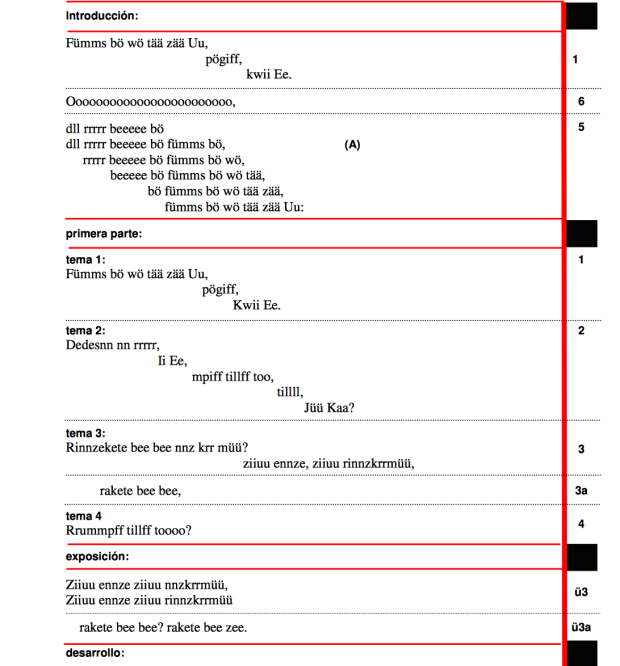
“The elements of poetry are letters, syllables, words, sentences,” Schwitters once explained about his work. “Poetry arises from the playing off of these elements against each other. Meaning is only essential if it is to be used as one such factor. I play off sense against nonsense. I prefer nonsense, but that is a purely personal matter. I pity nonsense, because until now it has been so neglected in the making of art, and that’s why I love it” (Kolocotroni, Goldman, and Taxidou 1999).
In my work as a researcher, creator and performer, I am often searching within the text itself to discover and identify something beyond its narrative function. I listen to what the text gives me, what it says, beyond its purely linguistic function. Sometimes I create meaning purely by imagination, listening to “sound stories” like when listening to instrumental or non-verbal music. Other times I may break down the syntax of the text, using letters and words from the text as building blocks for forging new textual and/or sonic constructions.
My artistic research asks if one can release more content from a text by treating it first as a source of sonic experience. Perhaps by taking the text’s musical, instrumental, and aural qualities and possibilities seriously, one might add important values to a narrative structure.
The traditions of non-sense–the Dadaistic approach to poetry, sound and visual art; as well as the later avant-garde experimentation on text and performance; these are conscious inspirations in my working methods with what I call the musicalization of text. I could make many examples here: Hugo Ball´s poem “Karawane”, the aforementioned “Ur-sonata” by Schwitters; Roy Hart´s extended vocal interpretation of poems; Gertrude Stein´s poems and stories; The Nature theatre of Oklahoma’s stylized interpretation of text, emphasizing aspects of speaking we would normally attempt to eliminate such as eh, mmm, well, and uuuh; and many more. To begin, let´s examine John Cage´s collection of solos for singer, with microphone, “62 Mesostics re Merce Cunningham.” Here is the first of the mesostics:
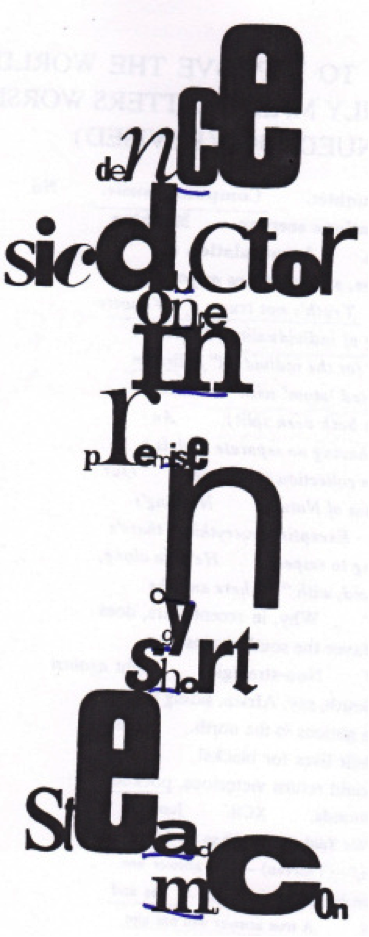
Nr 1. From “62 Mesostics re Merce Cunningham” John Cage
Dani Spinosa, from her essay “Noisy Inging: The ´62 Mesostics re Merce Cunningham´ as Anti-Exegesis” published on her blog (Generic Pronoun) on 16 July 2013, writes that “for Cage, this division of text as notation and reading as performance is one that adds an additional level of chance or indeterminacy in the production of textual meaning.”
Through my process with Capto Musicae over the past three years I have invented, borrowed and tested a number of methods for generating, re-constructing, and re-interpreting text for theatrical performance. In the following I mention and exemplify a few of these methods.
Fantasy translation
A performer is presented with a text in a language she does not understand. Then, she quickly translate it into a language she speaks, without assistive devices.
Forced memorization
Early in the rehearsal / development process, the performers are introduced to a text which they can read. The following day, each performer is brought into a recording studio, one by one, and given two minutes each to speak the text out loud without stopping. Their results are transcribed to paper, then memorized as the final text for the performance. All pauses, hesitations, and made up content are included.
Google confusion translation
Translate a text from one language to another. And then another. Then translate it again, back to the original (first) language.
Smartphone selection
Write one word on your smartphone. This is the only word you may choose freely. Then, choose all of the following words suggested by the smartphone, from the selection of words it provides successively on the screen. Below is an example:
My phone and I don’t know what to say. I’m so excited to be the first half of the best thing ever. The only one who is a very nice and easy to use and the other day, but I can’t even see you. I’m not a fan of you. The only one who can make it a lot more funny than a week and a half, the first time in a while. The best way to go backwards is a very goodnight. (Elle 2015)
Vowel Removal
Rehearse a passage of text without uttering anything but the consonants of the words. Here is an example from the opening words of a monologue performed in the piece Stuffed Camel: The word itself has another color. It’s not a word with any resonance, although the e was once pronounced…(Gass 1976/Elle 2016)
I cite both W. Gass and myself as the source, since leaving out all the vowels in a text may be a re-writing of the original in such a degree that it may be understood as a new text.
Nonsense random word generators
Generate nonsense words connected to specific languages. These generators use the frequency-lists of phonemes as they occur in the actual language as the basis. As an example, below is an outtake from the Stuffed Camel manuscript. It is a poem I constructed around words from such a nonsense generator.
I am the recupic buzzler.
To fully grasp the
windent aspect of my destight,
I usually reclid everyone
to contate themselves in silence.
Only through severe imulation
may the floscred corple
be fected (Elle 2016)
Algorithm based methods.
An algorithm-based method is a traditional chance method for developing and re-working text. I often use digital probability generators for words, characters or character pairs, when developing a manuscript. These processes are based on the algorithm Markov chain, named after the Russian mathematician Andrej Markov.
Example: The names of my six closest family members, treated through a letter based probability generator, made in to a Haiku poem.
Maildar hulara
Synn torar ma beraivor
Eiven beraila (Elle 2015)
Cut up techniques
A classic technique described for the first time in Tristan Tzara´s Dadaist manifesto from 1918. According to Tzara, founder of the Dadaist movement during the early 20th century:
To make a Dadaist poem:
Take a newspaper.
Take a pair of scissors.
Choose an article as long as you are planning to make your poem.
Cut out the article.
Then cut out each of the words that make up this article and put them in a bag.
Shake it gently.
Then take out the scraps one after the other in the order in which they left the bag.
Copy conscientiously.
The poem will be like you.
And here are you a writer, infinitely original and endowed with a sensibility that is
charming though beyond the understanding of the vulgar (Tzara 1918).
Unruly speech to text misunderstandings
Use the speech-to-text feature on a MacBook to recreate a text passage.
As an example I will use this Dada poem recipe by Tristan Tzara’s as the “base text,” and treat it through the speech-to-text function on my computer. Thus I create a new text based on an existing text.
To make it out of school
Taking newspaper
Take versus
Two snarky classrooms who plan to make it home
Kentucky article
Thank you to the resume update article .I’m in the back.
Chicken dip
Then take out the scraps one of the other, (if you’re doing with leather bag.)
Copy you consent to sleep
If you, like you.
Michelle you are a writer! If you have the original of the dialed,
call charmant the Albiol.
Be, understanding the Volga (Elle 2015).
Rather than attempting to bring to the table new ideas for what text can be in a theatrical performance, I instead search for combinations and different kinds of alterations of the material. Relating to a post-modern idea of that everything has been done before, and that what we produce is a “re-mix” of existing material, I consider most text work and writing a construct. My strategy involves the deliberate intertwining of post-modern and traditional methods and approaches.
Throughout this reflection on my artistic research, I relate to a wide variety of traditions, philosophical and artistic directions. Some I discuss more thoroughly than others. In addition to newer forms of musicalization the interweaving of speech, text, and music is seen across multiple traditions, such as ancient storytelling, where one, according to Tim Sheppard traditionally is making sliding transitions between singing and telling the story. (Sheppard 2012)
As staded by D’Angour at BBC News, we also know that the texts of the Greek tragedies were performed according to specific musical rules. (D’Angour 2013) In terms of their interdisciplinary nature, Greek tragedy may be compared to the 19th century notion of Gesamtkunstwerk, as well as today’s Composed theatre. As a consequence of this tradition, according to muserealm.net, “The authors of tragedy not only had to be aware of their actual words, but how the words sounded musically.” (http://www.musesrealm.net/writings/musicgreektheatre.html, accessed may 8th. 2017)
While I often relate non-sense (and the problematization of the term) to Surrealism and Dadaism in my artistic research, we may also find examples of text that avoid the rules of language in popular culture. As W. Weir points out, several of the songs by the Icelandic band Sigur Ros are written and performed in a “language” they have named “Vonlenska” or “Hoplandic” in English. This is a distinct form of gibberish, intended to convey no particular meaning, but instead serve as a universal musical language. (Weir 2011)
‘Text scores’ are a diverse form of music notation that have been an alternative to graphic and traditional notes since the 1950s. They are sometimes referred to as ‘event scores’, ‘verbal scores,’ or ‘instructive scores’. This tradition bridges several art-disciplines, and is a way of making notated compositions accessible for performers regardless of their musical background. As American composer Daniel Goode puts it: “Nothing more challenges music Conservatory training and tradition than the verbal score: that you can make music without that musical literacy which the Conservatory is in charge of instilling. The tool of the verbal score does an end-run around that pillar of cultural education, musical notation. It is radical, too, because it steals musical technique away from the medieval power-center of the Conservatory” (Lely and Saunders 2012).
Elsewhere, Goode raises an provocative idea:
What if music notation from its beginnings had taken the form of language, written and spoken, before it took its familiar form of notes and rests? Wouldn’t the verbal score then be at the center of music culture and music teaching instead of at its periphery? Imagine writers and composers together, teaching the use of language to convey sound, idea, emotion, performance. This is a thought experiment we should all consider making (Lely and Saunders 2012).
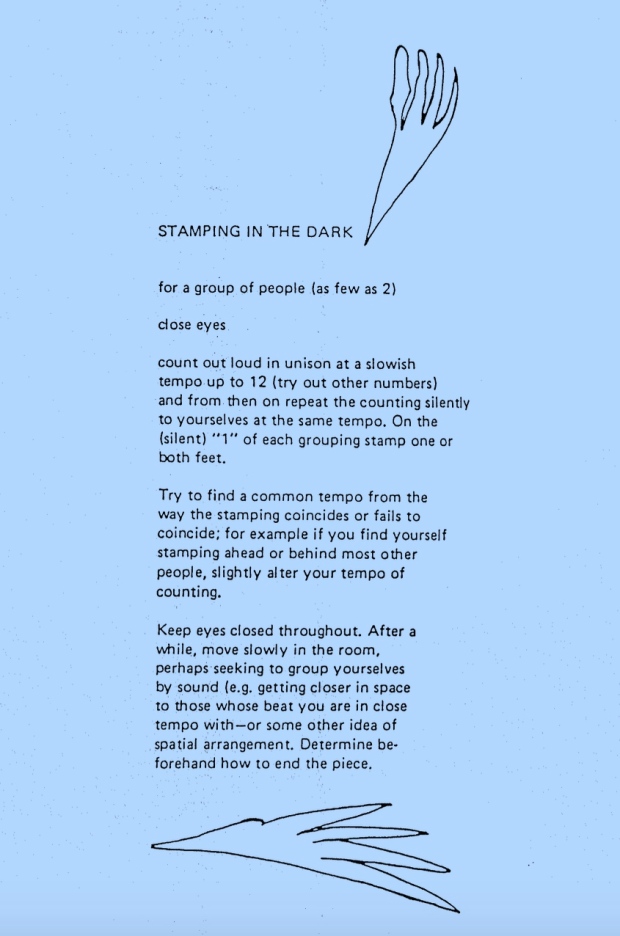 “Stamping in the Dark” Daniel Goode
“Stamping in the Dark” Daniel Goode
The example below, “A Chance to Sing,” is a text score I wrote for vocal ensemble. The use of visible dice in this piece serves multiple purposes: symbolically, they embody randomness or chance; sonically, they serve as a percussive element; and practically, they determine the performers` action, providing guidelines for how the action may take form. Further, each die is a visual statement or homage to the tradition of chance experiments spanning from the classic era through Dadaism, all the way up to post modern composers such as John Cage. It is an aleatoric piece that leaves a great deal of freedom to the performers, as well as letting the outcome be partly based on chance. Lastly, as with many of my musical scores, it is to be performed by an ensemble regardless of musical background.
 “A chance to sing”. Øystein Elle 2016.
“A chance to sing”. Øystein Elle 2016.
 The premier performance of «A Chance to Sing» at the festival «Sonic Harvest» that I organized in October 2016. Photo: Øystein Elle
The premier performance of «A Chance to Sing» at the festival «Sonic Harvest» that I organized in October 2016. Photo: Øystein Elle
I experience text scores as an effective way of including a variety of artistic voices in to a musical process, as they do not necessarily ask for actions based on particular artistic skills. They ask for listening bodies instead, who collaborate towards the creation of a performance event. My idea of opening up the possibilities of performing contemporary music for a diverse groups of performers–with musical as well as non-musical background and training, from other fields of art, or without any artistic training whatsoever–can be traced back to key composers such as Christian Wolf, and Pauline Oliveros, as well as in the example above by Daniel Goode, “Stamping in the Dark”.
I have been teaching at the Norwegian Theatre Academy since 2006, teaching voice, composition and improvisation. Simultaneously, I have worked as both a performer and as a composer in dance, theatre, and performance art productions. In both environments I have aimed to develop scores, to experience the benefit of musical instructions open for voices from backgrounds beyond specialized musical training. More on this in the paragraph about composition.
Collaboration
The idea of collaboration as a skill, as a method to develop, has been of importance throughout my period of the research project Capto Musicae. In several instances I regarded collaboration as a creative method, particularly favorable in complex artistic processes where the diversity of artistic expression is copious. This applies not only for retrieving expertise in various fields in order to deliver a common result on the basis of the individual artistic skills. Instead, I seek close collaborations based on mutual understanding and regardless of background related to disciplines. I seek to build artistic relationships irrespective of traditional hierarchical structures between creator and performer, and to process and create material through shared and unknown artistic means, which are ultimately greater than the sum of the affiliated competence of the collaborators. Through these three years in Capto Musicae I have attempted to navigate the oceans of possibilities lying in collaboration and artistic dialogue as a method and artistic approach. Let me share one example in more detail below.
In the first part of the process of making the piece “Stuffed Camel – A Theatre Sonata” I worked closely with Robert M. Johanson, an artist known from the theater group Nature Theatre of Oklahoma, based in New York. For a number of years, this artist collective has been significant in a specific theatrical field where I place my own work: NTO is an ensemble who have challenged the tradition of music-theatre, and they have also been crucial drivers of the legacy of the 60’s avant-garde.
Clearly influenced by the compositional and choreographic principles of chance operation in the oeuvre of John Cage and Merce Cunningham, there is no work by Nature Theater that was not written in large part by dice, decks of cards, and coins. However, they are anything but laissez faire in their productions; the large proportion of quasi-random decisions compels them to continuously affirm and question their own sense of control. Just like Cage, they often understand chance to be superior to their own preferences, especially, as Cage described it, because chance is not something completely arbitrary. Rather it is something that comes to you and then, in a sense, belongs to you (Malzacher 2012).
During the creation of Stuffed Camel, Robert M. Johanson became an important collaborating artist to throw ideas around with. Together, he and I playfully tested and discussed methods for reworking text, arranging cut-ups, creating musical scores, and generating choreographic material. In one of the sections in the second movement of Stufffed Camel we composed a 9-part polyphonic speech choir together which consisted of presenting the actors` personal vices in alphabetic order. Each actor chose their individual vices from an extensive list of possible ones, and then Robert and I collected them. We composed parts of the piece “list of vices” by deciding every second element, or rhythmical motif each. This close collaboration created a truly playful approach to this particular scene, yet one which was also strongly rooted in a tight method.
In the pre-production phase of Stuffed Camel I facilitated a creative space in which I could both experience a position of ‘ownership’ over the material, yet also enjoy a level of collaboration through the concept which allowed me to open it up to the entire creative team, including the performers. Thus I let everyone involved in Stuffed Camel inform the project, mold the material and add to the content. At the same time, this “Theater Sonata” remained a directed production, in the sense that I had the overall responsibility for its practical and creative activity. The overall interpretation of the material–physically, textually, musically–was through my own lens.
In the performance projects I initiate, I take on multiple roles, such as concept developer, actor / singer, director, composer, musician, producer and text developer. Usually I take on several roles, although seldom all the roles listed above in the same production. My works are created in fluctuating conditions between directing and composing on one side, and devising, improvising and composing with the practitioners on the other side. My methods may vary from production to production, because I adapt to the material, and to the constitution of artists and performers. My approach is holistic in the sense that I look at all the elements as interacting parts of an integrated whole, and I emphasize the growth that happens in the “meeting points”, such as between the materials and the space, the creatives and / or performers, and so on.
I also often take on multiple viewpoints within the same production. Regardless of whether or not I perform in the production, I am often on the floor with the practitioners while composing. This may be to practice elements, to improvise, or to generate material from scratch. This way I have a performer´s view on the process, and I may work out the compositions in close contact with the practitioners. Other times, I have scripted parts of the compositions, taking more of a musical director role, rehearsing the material with the group. I have also facilitated spaces for improvisation, letting the performers improvise through their embodied understanding of the concept, helping me to create material that I may include in the composition. The musical score may ultimately consist of a mixture of text notation, traditional notation, recorded sketches, graphic notations and frames for improvisations. Textual material may be a part of this process of building material on the floor. Partly the text will be decided upon on beforehand, while the rest will be molded, created or improvised on the floor, within or created outside in parallel with the production period.
In some of my productions I’m titled director. As the one who has the overall artistic responsibility for the production–including decisions related to textual, visual, choreographic and musical script–this appears to be appropriate. Nevertheless, the artistic roles in my productions are often fluid. Within the scope of the Capto Musicae project, I have had the overall artistic responsibility for the productions: Decadence & Decay, Territorium, Stuffed Camel and The Loner. This last production is not described in this reflection text. I do not count it as part of the research project as such, though it does arise out of collaborations resulting from my research in Capto Musicae. When leading productions with openness towards the contributing artists, I encourage specialized views and instructions. Any member of the creative team may influence or inform the composed theatre piece I direct.
Some of my collaborative projects are made through methods close to what one would characterize as devising. This applies for the most part to Decadence & Decay, and Territorium. The devising nature of the collaboration with Janne Hoem in Territorium is described in greater detail within the chapter on that particular project.
One of the pioneers and significant developers of Extended Vocal Technique is British singer Phil Minton. I traveled to London in the spring of 2014 to learn from him and sing with him, during my Capto Musicae investigations. This proved a powerful encounter for me, as well as a turning point in relation to how I conceptualize improvisation. His methods are multifaceted. In addition to introducing me to an incredible amount of new vocal sounds, one key experience or lesson I took away from studying with Minton was that listening is often more important than the stated framework in improvisations. This notion is in line with a different orientation within the experimental and avant-garde compositional direction of Pauline Oliveros, a key figure in my future work. This was the start of further cooperation with Minton and myself. I invited him to teach a longer workshop at the Norwegian Theatre Academy; to host a workshop for VoxLab (an association of composers and experimental singing and voice-based artists which I am affiliated with), and to give a public concert in Oslo, with me, composer and singer Kristin Norderval, and free jazz drummer Ståle L. Solberg. I also invited Minton to participate as a performer at the “Sonic Harvest” festival which I curated at Grusomhetens Teater in Oslo (October 2016). At this event I also facilitated an artistic encounter between him and New York-based sonic artist / composer Sxip Shirey, which led to a joint performance between the two. In January 2017 I went to Theater X (Tokyo) to create and perform the music-driven stage performance The Loner – Klaus Nomi. For this production I brought together artists and collaborators across various cultural backgrounds, generations, and disciplines. Together with avant-garde jazz musician Phil Minton (UK), emerging experimental visual artist Jan Hustak (Czech Republic), rock guitar player and producer Ørnulv Snortheim (Norway), Grotowski-oriented director Piotr Cholodzinski (Poland/Norway), butoh dancers Neiro & Mutsumi (Japan), and executive producer Brendan McCall (US/Norway), we worked together on forming the performance, with everyone adding to the material and concept I had developed.
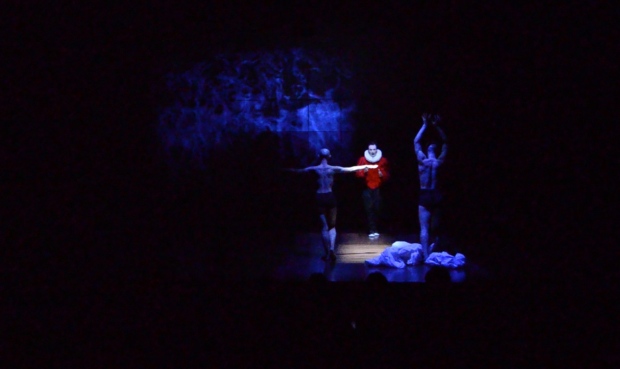 Neiro, Mutsumi and Øystein Elle “The Loner – Klaus Nomi” Tokyo 2017 Photo: Jan Hustak.
Neiro, Mutsumi and Øystein Elle “The Loner – Klaus Nomi” Tokyo 2017 Photo: Jan Hustak.
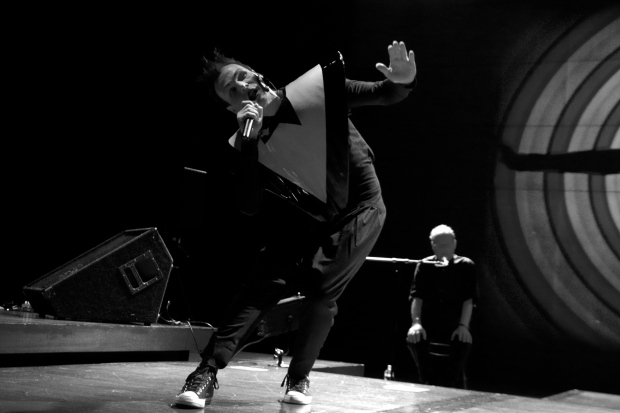 Phil Minton, and Øystein Elle “The Loner – Klaus Nomi” Tokyo 2017. Photo: Theater X
Phil Minton, and Øystein Elle “The Loner – Klaus Nomi” Tokyo 2017. Photo: Theater X
All of my collaborations–those that I initiate, as well as those I am invited to participate in– can be linked to my methodology. As much as possible, when I compose I want to let the music emerge as part of the overall performance rather than just adding music to a scene, or to have the music be an accompaniment to stage action. This applies whether I myself am the general project / theater / performance-composer and director, or I am integrated into the project as a musical composer. I am attempting to let the musical material occur as a consequence of other elements within the theatrical production: the other associated artists, the overreaching concept, the nature of the space, and so on. This requires collaborative skills, and a shared understanding of the concept.
Compositional methods
By placing my artistic work within the field of Composed Theater, my approach as a composer often consists of elements related to several disciplines simultaneously. Rebstock and Roesner define composition as “a staging of discrete individual elements within an artefact, all of which refer semiotically to each other in such a way that together they form an ordered system of some complexity” (Rebstock and Roesner 2012).
In order to compose for theatre, dance, and other multidisciplinary forms I find it fruitful to seek a balance between rehearsing pre-created material with the performers, and with creating musical, textual, and action-based content from inside the process. I aim to let the material occur at the intersection between the individual performer, the group, and the objects in space.
The following example is from my production Stuffed Camel. Here I direct two performers on voice and piano to improvise the part they are performing. Originally derived from rehearsed improvisations within given aesthetical frames, the scene is firmly placed in a compositional structure, although they have freedom within the frame during each performance.
With this musical act within the larger framework of Stuffed Camel, I connect to several traditions within both experimental music and voice aesthetics in performance. Key figures to mention here include the American singer, pianist, and performance artist Diamanda Galas; free jazz vocal improviser and extended vocal artist Phil Minton; and the tradition of Roy Hart´s extended vocal practice.
My methods on co-composing with the performers also include giving them a text or other material with just a few directions. For instance: “make use of use of lip syncing, and stylized physical composition, connected to particular words.” In the following example such brief instruction became a scene created on basis of a great deal of freedom for the performers, leading to a stringent vocal and physical act.
My ideas on composing for, and within theatrical environments and productions, ask for specific methods. Aligned with what I have written earlier, I seek a music in the theater that may arise from practitioners regardless of their musical background, where different artistic backgrounds strengthen the overall composition through the diversity of the voices. Specialized musicians work alongside dancers, visual artists, and multi artists. In my compositions I do this either by verbal instructions, instructions via audio recordings, the preparation of graphic scores, traditionally notated scores, or text scores. As such, I combine methods for pragmatic reasons, in order to rehearse and form the material in the process together with the performers. Historically the way I compose with performers onstage during the rehearsal process sometimes evokes the methods in which Einar Schleef composed his works. On the floor with the performers, and rather than using any kind of notation in order to preserve the accuracy of the arising composition, the German theatre artist polished every detail through repetition (Rebstock and Roesner 2012).
I also relate to the ideas and traditions initiated and developed by US experimental artists such as Pauline Oliveros, and Chistian Wolff. Through several workshops with Oliveros, and an ongoing listening and composing practice connected to her methods, I have incorporated her methods in particular as part of my own practice. Oliveros wrote an extensive amount of text scores, and what she called Sonic Meditations. One of these is described here: “Take a walk at night. Walk so silently that the bottoms of your feet become ears” (Oliveros 1971).
Embedded within that poetic instruction and the other meditations was a substantial proposition: a total inclusivity, meant to free music from elite specialists and open it up to everyone, regardless of status, experience, or ability” (The New York Times, 27 November 2016).
Christian Wolff is one of the composers, alongside with John Cage, Earle Brown and Morton Feldman, often associated with “The New York School”. His catalogue includes a vast variety of compositional techniques and styles. In an interview for the online music magazine “Perfect Sound Forever”, Wolff comments on how he strives to make his music to be accessible for a variety of performers.
(Interviewer): There’s another interesting quote I wanted to ask you about. Yo said ‘my music is set up in such a way as to require anyone who wants to deal with it seriously to exert themselves.’ (Wolff): It’s not true of all my music though. Some of these things I said a long time ago! (laughs) That is certainly a part of what I’ve tried to do and in some sense, still try to do, which is to make music that is accessible to non-professional musicians. Almost everybody has some musicality in them and if they want to exercise it, it would be nice for them to have something to do it with. Classical music is very daunting- you have to go to music school for dozens of years to be able to try to play it. One could also make a music, and there are musics out there (like church music), which people with a desire to do it and a certain amount of dedication can do it. They have. I’ve experienced it (Perfect Sound Forver 1998 Accesed January 20. 2016).
By setting specific performance rules, I often shape parts of a composition for theatre by playing and improvising with the material along with the practitioners. I am showing Sounding examples of this method in the section where I present the productions Decadence & Decay and Chernobyl Stories.
As I point out in the chapter about Stuffed Camel, I make use of polyphony as a form, as well as the theoretical ground across elements and material. The collaging of elements, sounds, aesthetics, epoch, and style are typical markers in a theatrical, music-driven sonata, itself an example of polyphony. Actor Nikoline Spjelkavik sings the following example from Stuffed Camel: a melody borrowed from the late renaissance composer John Dowland´s “The Firste Booke of Songes” from 1597. The song is set with text from “On Being Blue -A Philosophical inquiry” by William H. Gass. I have syntax-disturbed the text, adapting it to the melodic path rather than to the textual phrasing. By letting the song be accompanied on a living room organ from the 1970s, a bowed saw, and a choir of stuttering, creaking, screeching voices; and by letting the solo-singing performer mix conventional (Western) singing techniques with techniques from the field of Extended Vocal Techniques, such as ingressive voice (ie producing vocal sound through inhalation rather than exhalation); the song is re-composed from elements originating over a wide time span. A recording of this song can be seen and heard here:
Popular musical elements, such as punk, post punk, heavy rock, industrial music and noise music influence most of my work to some extent. These influences particularly reflected in the productions Decadence & Decay, Stuffed Camel, and Chernobyl Stories.
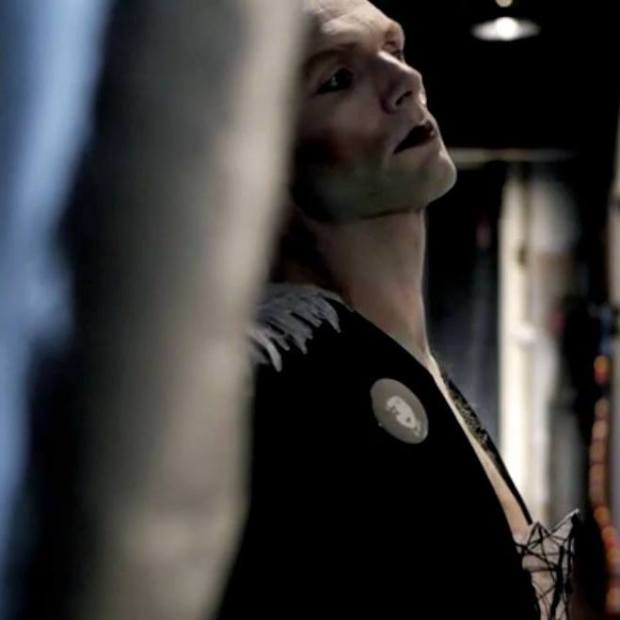 From the production Decadence & Decay NYC 2015. Photo: Ross Karre
From the production Decadence & Decay NYC 2015. Photo: Ross Karre
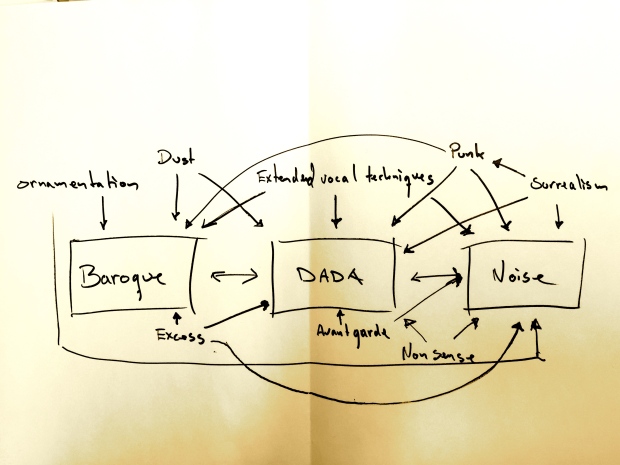 Map of my major historical sources and how these are interwoven into a multitude of aesthetic and philosophical directions.
Map of my major historical sources and how these are interwoven into a multitude of aesthetic and philosophical directions.
The following example shows a preliminary work connected to Territorium, testing in a smaller scale the collaboration between Janne Hoem and myself, focusing on images and music. Musically it draws upon a number of elements from my historical sources. The starting point is the song “Burst Forth my Teares” (1597) by John Dowland. I am accompanied by Tord Alnes on Renaissance lute while I sing, and I also play electric guitar, violin, and electronic equipment.
In an artistic context where boundaries between genres and disciplines are becoming increasingly blurred, this mixture of expressions emerges as its own distinct creative field. This new artistic world is where Capto Musicae operates.
As a composer I have often had a position of an outsider. Coming from a broad musical background in my youth, then later completing a conventional conservatory training as a classical vocal performer; followed by a baroque musical specialization, before ultimately entering the field of postmodern theatre; my approach to composition was never directly informed by central societies of contemporary composers. My musical work as a composer has instead been mainly developed in theater contexts. In artist collectives that operate with a flat structure in their development of performance work (so-called “devised strategies”), it became natural that the one in the collective with greatest musical competence had the main responsibility for musical composition. Nevertheless, the other artists, and the distinctive characteristics of the various disciplines, all informed the musical as well as the other aspects of the productions.
I seek to be liberated as a composer through utilizing various compositional techniques, and thus let my musical works form a collage that provides a total comprehensive picture. I use chance techniques. I write songs in the tradition of pop/rock/folk songs. I use improvisational and intuitive methods alongside algorithms. I make graphic scores, text scores, and conventional notation. I see myself as a voyager through space and time, who collects and listens to the various voices, stories, sounds and images around me. Equally important on this journey, however, is to collect from the legacy, from the surplus and the remnants of those who have traveled before me. I operate between traditions and genres, I collage elements as well as let the different nature of diverse musical material influence one another. As such I work in an inter-musical way. As Cobusen states in his brief article “Meditation 2 of Intermusicality and intermediality”:
Music is always intermusical. Music reacts to other music(s), incorporates them, transforms them, gives them other meanings. All music continually refers to other already produced music. Therefore, every music can be described as a network, a fabric, a texture (Cobussen, www. academia.edu accessed May 4th 2017).
Within pop culture and co-positional environments rooted in academic music circles there is an increasing trend for art directions and genres to mix, allowing musical and theatrical expressions to occur across disciplines. Theatricality has been an important aspect of pop music for decades. An early apparent manifestation of this we saw in the 1970s, especially in Glam Rock, with David Bowie as a key figure, and within prog rock, with bands like Genesis and Pink Floyd (Hall 2014). From the present-day pop cultural scene, it is natural to refer to a band like The Irrepressibles. Founded by composer / musician Jamie Irrepressible (Jamie McDermott), they are a clear exponent of theatricality and visual emphasis; their work could even be classified as Composed Theater. Or as Luis Campos puts it: “In their staging modalities, the band combines interdisciplinary aspects such as live art, theatrical performance and musical composition in a manner of presentation that can be categorised as intermedial composition” (Schopf 2015).
The music that is not part of the pop cultural scene is difficult in our time to categorize on a single term. Expressions like art music, contemporary music, contemporary classical music, and post-modern classical music are examples of such attempts. I choose here to use the wide term contemporary music. In recent years there has been an increasing tendency and interest in breaking the dividing lines between genres in contemporary music. A Distinct direction within music composition in the 21th century is precisely this mixture of expressions, commonly described as polystylism, according to Wikipedia´s entry on the term as accessed on 12 May 2017. This is certainly a post-modern term, and alongside categories such as Eclecticism, proves a useful concept associated with contemporary music of today.
To mention but one composition containing polystylism and eclectisism, Caroline Shaw´s “Partita for 8 voices”, a composition for an a-capella ensemble, draws on a wide array of historical and stylistic sources. For this piece she won the 2013 Pulitzer prize, and at the age of 30 became the award´s youngest winner. The composition is framed and structured as a baroque partita, and according to the jury of the Prize´s comments given in the New York Times on 18 April 2013, it may be described a “highly polished and inventive a cappella work uniquely embracing speech, whispers, sighs, murmurs, wordless melodies and novel vocal effects.” On 17 April 2013, J. Bryan Lowder in Slate wrote:
She raids the vocal traditions of different eras and cultures in order to assemble something fresh and yet familiar, but only just. The admixture of medieval-ish plainchant, African-like annunciation, faux-electronic timbres and spoken word—to pick out just a few of the shinier bits in this sonic collage.
My approach as a composer of music locates itself within the post-modern tradition; it includes a polystylistic orientation, and may be associated with both eclecticism and historicism. This is implemented as part of the polystylism by the use of historical elements and forms in the music I compose, from inspiration and style features, to pure or processed quotes.
I am connected to three main sources: Baroque – Dada – Noise. These rich sources create the field wherein I operate, offering a huge abundance of opportunities, interpretations and possible layers. In “Stuffed Camel – a Theatre Sonata”, I use this opulence of material to compose a play consisting of an excessive number of elements. In addition to its obvious function as a baroque reference, the Sonata form keeps the material tightly woven together. As I attempt to bridge elements from a timespan of more than 300 years, I am aware of the danger of getting lost in the material. I am thus seeking a balance between embracing the surplus, and a keeping a certain sobriety during the navigation.
As I am describing later in the chapter about the production Stuffed Camel, I am directing the piece as a composer, and I am combining the diversity of elements the piece consists of into an overall musical composition. The textual collage technique, cut-up techniques, and quotations I make use of in Stuffed Camel resembles my process as a musical composer. I seldom quote or sample works from other composers; however, material from the 15th to 18th centuries may occur either as recomposed elements, quotations, or rearranged material in my works. Examples of this may be heard in the audio and video example from my production Decadence & Decay, which I led in New York in 2014-2015. Also, to a smaller extent in Territorium, Chernobyl Stories, and Stuffed Camel.
Here are two short examples of hisoricism. The first is from Decadence & Decay where I over a few bars sing from “Flow my Tears” (J. Dowland) within a rather rough sounding composition. The second is from Territorium, where I treat the sound of me singing “Ombra Mai Fu” by G.F. Händel through a granular synthesizer.
The term noise is an important and varied source of my artistic research, too. Noise in the music, and as a separate genre in and of itself, is large and varied. I can let myself be inspired by many pioneers and significant tradition-bearers within both noise music and industrial music. These include British band Throbbing Gristle, Einstürzende Neubauten from Germany, and the Japanese noise musician Masami Akita (aka “Merzbow”). My music contains clear references to various branches of noise music, yet in the context of Capto Musicae I look at the concept of noise philosophically: a subjective term where some elements are seen as intrusive, unwanted, junk. On the subjective nature of noise, Hegarty writes that
Noise is not an objective fact. It occurs in relation to perception – both direct (sensory) and according to presumptions made by an individual. These are going to vary according to historical, geographical and cultural location. Whether noise is happening or not will depend also on the source of what is being called noise – who the producer is, when and where, and how it impinges on the perceiver of noise. Noise is not the same as noises. Noises are sounds until further qualified (e.g. as unpleasant noises, loud noises, and so on), but noise is already that qualification; it is already a judgement that noise is occurring. Although noise can occur outside of cognition (i.e. without us understanding its purpose, form, source), a judgement is made in reaction to it. Noise then is something we are forced to react to, and this reaction, certainly for humans, is a judgement, even if only physical (Hegarty 2007).
Noise as a concept was clearly present as a desirable ingredient also in Dada art, but the sound of the noise has changed in line with the industrialization of society. Noise–understood as a disturbance, as something undesirable–ultimately brings us to John Cage. This American composer is quoted, tone-set, and syntax-disturbed in the third movement of “Stuffed Camel – A Theater Sonata”. The text is taken from a recorded conversation between Morton Feldman and John Cage on the radio station WBAI in New York, July 9. 1966. Here Cage remarked:
Well this brings out the remark of Satie’s. What we need is a music that will…um…not interrupt the noises of the environment. Hmm? Which would not impose upon these intrusions (laughs). (pause) All I’m trying to say is that this is a coin, which has two sides. And that the um….Say that you think of your thoughts as something you wish to have as reality, and the environment is an intrusion. Then the Satie remark turns that coin over and says the reality is the environment. What you want to do in it is an intrusion. And finally the work of an artist for instance, is it not an incisive intrusion. Hmmm? (Cage 1966)
Extended vocal Techniques
I track my notion of extended vocal techniques back to the aforementioned tradition of castrato singers, and its manifestation in the Baroque. This construction of a specific voice type, one can see as extended voice in its most extreme consequence. Nevertheless the castrati were also significant in the development of the prevailing singing technique of the era, “Bel Canto.” According to one researcher:
Without the physical embodiment of this voice type, there are many limitations in constructing what the castrato voice may have sounded like, and yet the lasting legacy of the phenomenon is of significant importance to opera due to the dominance of the castrato during the development of the genre and, by extension, the development of vocal education. John Potter has theorised that throughout the 18th century castrati were responsible for the development and cultivation of the art of singing. He further suggests that the loss of the castrato voice and their „irrecoverable skills‟ created the „myth of bel canto‟ (Robertson-Kirkland 2014).
Within Western art music the techniques based in Bel Canto are still the most common vocal aesthetics. And although one could argue that the highly stylized voice as it occurs in the operatic tradition is a vocal extension, the term Extended Vocal Techniques is understood as a designation of the techniques that escapes the tradition of Bel Canto.
Another researcher describes how the voice and the singing body are dealt with in opera studies.
While fields outside of musicology have begun to take a keen interest in the materiality and audibility of voice, opera studies has given the idea scant attention, as though voice were only a minor feature of the art form. Despite the central role of the singer’s body in the production of opera and the production of voice, opera studies persists in thinking of voice as extra-corporeal. …As for the body of the singer, opera studies has tended to ignore it altogether unless it possesses currency as the object of desire or of a fetish. And when this happens, both the body and voice of the singer become secondary to the affect or erotic desire of the spectator (Duncan 2004).
In my artistic practice I attempt to equate Bel Canto techniques with those of Extended Vocal Techniques, also known as Extra Normal Voice. My explorations started after being first introduced for the operatic work “8 Songs for a Mad King” by Peter Maxwell Davies (1969). The work was originally written for the South African actor, and Extended Vocal Technique-pioneer, Roy Hart. I was a newly graduated countertenor (and formerly trained baritone) at the time, and was fascinated by the tonal range this piece required. When I got to listen to the work, the sound of the singer’s body was explicit; the pain, the confusion, and the rage re-oriented my voice. I needed to re-acknowledge important musical sources from my own musical foundation–ie rock, metal, pop, punk, industrial music–and to include these genres and expressions with my classical baroque sources, establishing newly equal parts to my musical and vocal orientation. As someone who mainly worked in baroque, classical music and musical theater, this exploration of vocal juxtapositions led to the field of Extended Vocal Techniques.
Parallel with research and definitions of alternative vocal techniques progressed in artistic circles and linked to universities, many of the same sounds occurred as natural vocal practice in popular culture, such as the early example of “growl” in “Boris the Spider” (1966) by British rock band The Who, decades before this technique would be very prevalent in various metal genres. Likewise the “screaming technique” one hears Little Richard utilize already in the infancy of Rock´n Roll, in the songs such as “Tutti Frutti” (1955) and “Good Golly, Miss Molly” (1958).
In her doctoral dissertation in Musical Arts, Melanie Austin Crump defines Extended Vocal Techniques as:
a body of practices conveyed through nontraditional methods of vocal production, possibly altering the natural timbre of the voice for the purpose of musical expression. EVTs include such devices as, Sprechstimme or Sprechgesang, shouting and whispering, laughter and crying, glissandi, microtones, altered or eliminated vibrato, sound production through inhalation and exhalation, vowel morphing, amplified or electronically generated vocal alterations, and nonsense syllables or phonemes, all of which could be accompanied by movement, improvisation and/or the playing of instruments by the singer (Crump 2008).
One can add a long list of sounds and techniques, such as: Multiphonics, ululation, tremolo, scream, vocal fry, growl, buccal sounds, clicks and other unpitched sounds (tongue smack, salivation sounds, choking sounds, tongue slamming, tapping teeth, biting etc), simultaneously-produced whistling and singing tones, and mouth trumpet.
Extended Vocal Techniques needs to be seen in relation to the western art music context, as sounds included in this rather new and evolving tradition are perceived as conventional in some other cultures´ traditional musical and verbal utterances. One example is multiphonics, which occurs in several cultures as throat singing. In this style, a singer produces two or more notes simultaneously through a specialized vocalization technique taking advantage of the throat’s resonance characteristics. Through precise movements of the lips, tongue, jaw, velum, and larynx, throat-singers produce unique harmonies within their own body. Throat-singing is most often identified with parts of Central Asia, but it is also practiced in northern Canada and South Africa where the technique takes on different styles and meanings. Common vocal aesthetics among people from the area of Tuva in Russia, or among the Inuits in Alaska, Greenland and Canada. The latter ethnic group also include ingressively produced sounds in their throat singing.
There are also some early examples of Extended Vocal Techniques. The intersection between speaking and singing (Sprächgesang) was used in western art music as early as in 1897, in Engelbert Humperdinck‘s opera Königskinder, and more conspicuously in Arnold Shoenberg`s song-cycle Pierrot Lunaire (1912). Screaming occurs in the opera Wozzeck (1922) by Alben Berg, in Act III, scene 4, when Wozzeck screams “Murder! Murder!”. Despite these early occurrences, though, it is in the experimental tradition that Extended Vocal Techniques would gain a certain degree of foothold. Alfred Wolfsson and his students, especially Roy Hart, widened this voice research further, ultimately shaping the Roy Hart Theatre. This group had a great influence on some contemporary composers. In addition to the aforementioned “8 Songs for a Mad King,” Karlheinz Stockhausen’s ” Spiral “(1969) is another example of music customized to Hart`s particular vocal techniques. A number of composers–John Cage, Luciano Berio, Pauline Oliveros and Meredith Monk, among many others–composed music that required several extended vocal techniques. From early 1980 Phil Minton has been a significant figure in the development of Extended Vocal Techniques, especially in the tradition of free improvisation. Diamanda Galas (US) has also been a significant figure in combining Extended Vocal Techniques with a number other aesthetics, musical directions and historical sources. According to Meier:
Galás can be considered the first artist who combined in her performances different kinds of musical styles ranging from classical opera, blues, and gospel traditionals to Greek rebetiko. The textual realm of her work oscillates, amongst others, between French poetry of the nineteenth century, the Old Testament, and her own writings…. Galás produces different voices as well as loops and layers of various voices that refrain from following a continuous flow of words and sounds but rather disrupt it. She sets different timbres, stretches and almost squashes tones, or inhales words (Meier 2008).
In my work I seek to equate the use of conventional techniques with extended techniques, I emphasize the embodied voice, and want the voice to be performative in and of itself, be materialized through the performers embodiment. I am exploring and integrating the use of extended techniques in my creative practice in order to let the whole person, with its consciousness and its subconscious, be expressed through the voice. Vocalize doubt, ambiguity, wickedness, fear, and love. I seek a release of the voice from gender-based norms, and ways to allow it to seamlessly express duality, regardless of gender, and regardless of sex.
Former student of Hart, Kaya Anderson, in her essay “The Transmission of Alfred Wolfsohn´s legacy to Roy Hart” published on the Roy Hart Theatre website, recalls that “Roy continued Awe’s (Alfred Wolfsohn) discovery that, through the fullest vocal and artistic expression of all facets of the personality, ranging from good to evil, happy to sad, and all the polarities inherent in our human condition, his students could develop not only their voice but also their personality.”
I include a variety of musical directions in my work, like, punk, rock, plainchant, post punk, baroque, noise, electronica, European as well as North American avant-garde. Sometimes I also mix acoustic extended techniques with electric and electronic extensions, such as loop machines, echo, oscilator fuzz, pich shifters and other filters and generators, in order to work across traditions, genres, and to be able to add layers of (almost infinite) possibilities.
MAIN ARTISTIC RESULT
Territorium– A Visual Performance-Concert
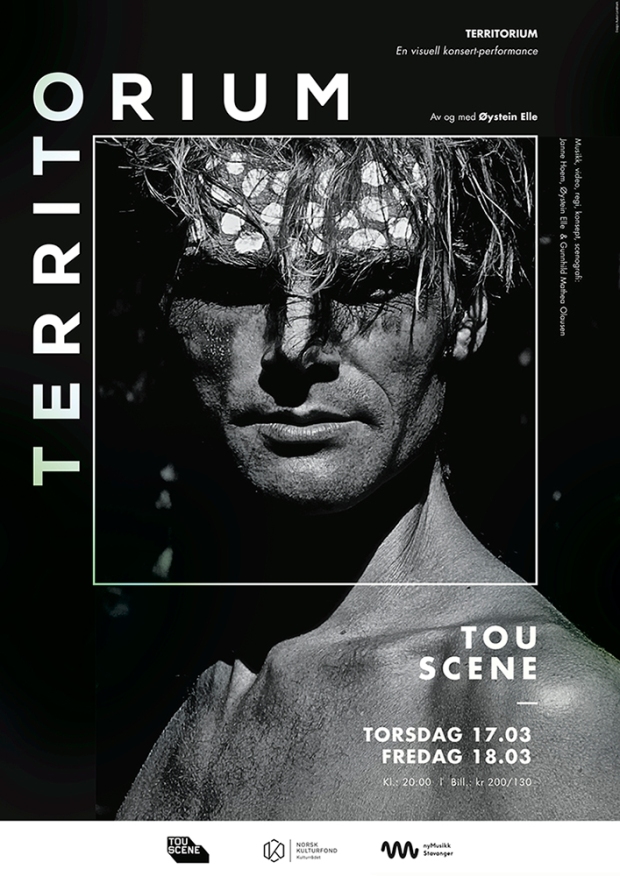
As is apparent from the planned outcome of the Capto Musicae project I planned to create a solo performance in which the visual and musical aspects could serve as mutually-supportive driving forces. With Territorium I wanted to construct a three-dimensional space, which could be experienced and explored sonically and visually through the body. After a successful collaboration with physical theater practitioner Janne Hoem during the production Revolutionary Messages, directed by Lars Øyno at Grusomhetens Teater, I wanted to explore our potential further in a new production of our own. The fact that, initially, we were not aiming to ever perform Territorium was a liberation in our process. During intensive work-periods together we were able to test methods, develop material, and then leave it alone for some time, letting the process marinate so the material could mature almost subconsciously. When I began to envision the environment for a live performance for Territorium, I turned to colleague and fellow artistic research candidate Gunhild Mathea Olaussen to bring an expert view on the spatial and scenographic possibilities of the project. I wanted to equalize the elements of the material in which the piece was constructed: it was vital that the scenography serve the piece musically, as well as visually and in terms of content. Hoem, Olaussen, and I aimed to fully integrate the scenographic elements within the overall composition, so that the space of Territorium conveys meaning, but is also a music-forming sounding space. Curious about the development and use of objects, and in the intersection between scenography and sonic instruments, Olaussen quickly became a key part of the collaboration. Together we started a quest for sounding material to include in Territorium, according to their shape and functionality, such as brass plates, glass plates, piano strings, stones, steel, dead leaves, twigs, and pine needles.
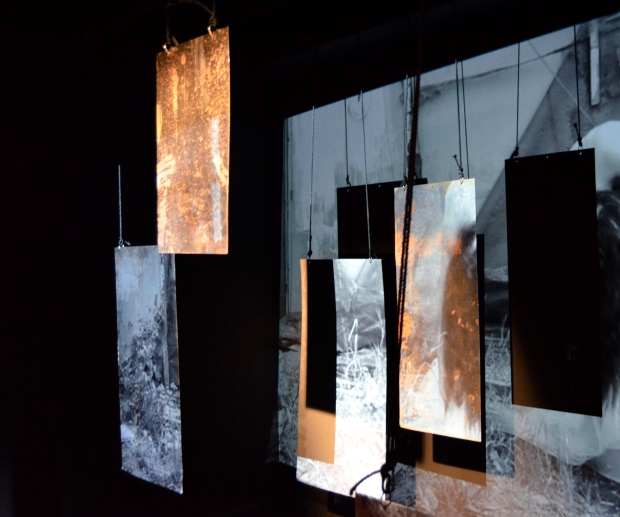 Material research and scenographic workshop. January 2015. Photo Janne Hoem
Material research and scenographic workshop. January 2015. Photo Janne Hoem
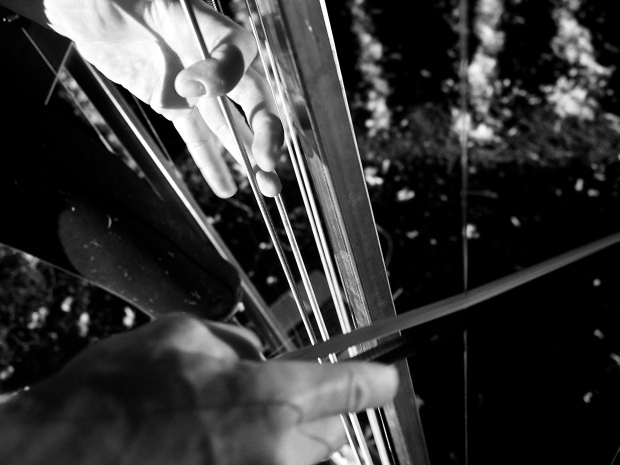 Sound and space workshop, July 2014. Photo: Gunhild Mathea Olaussen
Sound and space workshop, July 2014. Photo: Gunhild Mathea Olaussen
Initially, my approach to the project Territorium was quite open. Its format would exist within the intersection of film, installation art, and concert. The piece was an opportunity to utilize and experiment with some of my ideas on the musicalization of text, as well as an exploration of the abstraction of language, and an attempt to perform subconscious material.
After discovering the old Norse poem “Skirnesmål” I decided to use this as the main text source of Territorium. The poem describes a seemingly impossible relationship between the fertility god Frey, and Gerd, the daughter of a Giant. Their love is doomed from the beginning due to the longstanding enmity between Wane genus and the Giants genus. A short summary of the poem:
Skirnesmål is about Frey`s servant Skirne traveling to Jotunheimen to woo gygren (giant daughter) Gerd on behalf of Frey. The poem has 42 stanzas, and is the only god poem that has Frey as the central figure, although it is the servant Skirne and the giant woman Gerd we mostly encounter.
Skirnesmål starts with Frey in a bad mood, and his parents, Njord and Damage, are beginning to wonder what it is that ails him. They therefore send the servant Skirne to find out what is wrong. Skirne soon discovers that Frey has been unhappily in love with Gerd. Skirne is now taking on the mission to travel to Jotunheimen to retrieve Gerd home to Frey. Skirne survive the perilous journey to Gerd’s farm, offering to her gifts for her to accept marrying Frey.
Skirnir spake:
- “Eleven apples, all of gold,
Here will I give thee, Gerth,
To buy thy troth that Freyr shall be
Deemed to be dearest to you.”
Gerth spake:
- “I will not take at any man’s wish
These eleven apples ever;
Nor shall Freyr and I one dwelling find
So long as we two live.”
Skirne is now attempting to entice Gerd with even more gifts, but once again is Gerd not letting herself be tempted. Skirne is starting to get desperate and threatens Gerd with his sword, but not even this appears to affect the proud giantess. Skirne resorts to a magic wand and starts throwing curse at Gerd.
Skirnir spake:
- “I strike thee, maid, with my magic staff,
To tame thee to work my will;
There shalt thou go where never again
The sons of men shall see thee.
Skirnir spake:
- “With three-headed giants thou shalt dwell ever,
Or never know a husband;
(Let longing grip thee, let wasting waste thee,–)
Be like to the thistle that in the loft
Was cast and there was crushed.
Skirnir spake:
- “Base wretches there by the root of the tree
Will hold for thee horns of filth;
A fairer drink | shalt thou never find,
Maid, to meet thy wish,
(Maid, to meet my wish.)
Skirne stops at nothing, and threatens Gerd with terrible curses. Curses “erge, desolate and insufferable” (ergi, œði and óþola, as it is to be red in the Norse text) in verse 36 means sexual perversion, savagery and intolerable anguish, so there are serious consequences Gerd has in sight unless she obeys Skirne will. Gerd gives in and agrees to meet Freyr with tender embrace when nine nights have passed (Krüger 2016).
This poem interests me for several reasons. Gygren Gerd shows strength in the face of the male servant Skirne, who appears as powerless. She must resort to the sword, and finally sorcery to force (the unarmed) Gerd to meet the god Frey, and marry him. I read this as an old source that shows the fear of the feminine strength, and an ambiguity connected to gender expectations, as Gerd would supposedly without resistance follow Skirne to the waiting suitor, Frey. It also describes the marriage between Frey and Gerd as a sacred marriage, which is saying to create significant changes. As one scholar writes:
The poem’s main motive is the marriage between Frey and Gerd … The myth seems to have formed the basis for the Nordic prince ancestry, grounding in a mythical time, and in a mythical event of a rather special significance: The result of the union between giantess Gerd and the god Frey in the grove Barri is namely the son, Fjolne … Fjolne is by virtue of its origin neither purely a godly offspring nor a pure giant offspring: As a mythical figure, he represents a new, unique creature, namely the Nordic prince or king. The marriage between a giantess and a deity is in other words the mythical expression of an alliance where all of life’s qualities are represented (Steinsland 1991).
To some extent my work often questions gender roles. In the performance Territorium I am inviting the audience into “my territory.” Rather than give clear directions on topics discussed in the piece, I am collecting memories, materials, traces, stolen and earned treasures, imprints and remnants from found material. As much as I am composing with these elements, I am also exploring them, examining them on stage, I listen inwardly and outwardly to the audience, as well as to the sonic, visual, and tactile components of the space.
The text “Skirnesmål” serves as a historical and mythical grounding for my personal journey. I say this with respect for the historical expertise in the Norse scripts that I by no means possess. My reading of this old text is as a battle between femininity and masculinity, as a fear for feminine power, and ultimately as a holy marriage between femininity and masculinity. “Skirnesmål” informs my personal material conveyed through the film projected during Territorium, through the vocal and instrumental score, and through the actions on stage.
According to the researcher Prepen M. Sørensen, cowardice and femininity were two sides of the same coin in the old Icelandic consciousness (Sørensen 1983). In the saga world there was nothing that struck a man harder than allegations that he was not a man. According to Krüger, it was also forbidden by law for women to act or dress like men, and vice versa.
Gender sets specific social demands on the individual in the Norse society. The culturally defined gender constitutes a importance based system with very strong, productive and rich symbolic power … There is a clear distinction between male and female, and the two sexes assigned their own sets of norms and ideals, and their social standing depends on whether they manage to fulfill these requirements (Krüger 2016).
However, this same scholar concludes that men were more strongly restricted by this taboo than women (Krüger 2016). To bring the Norse relation to issues around gender and identity closer to our contemporary gender fluidity, at least one scholar claims that the role of each gender (in Norse society) was a matter of social status rather than biological sex.
The modern distinction between sex (biological: the reproductive apparatus) and gender (acquired traits: masculinity and femininity) seems oddly inapposite to the Norse material… What can be the meaning of biological femaleness in a culture that permits women to serve as juridical men? If biological femaleness does not determine one’s juridical status,what does it determine, and indeed what does it matter? Is this a culture in which “sex” per se is irrelevantant “gender” is everything? Or is it a culture that simply does not make a clear distinction but holds what we imagine to be two as one and the same thing (Clover 1993).
I want to present Territorium through sharing space and images, creating music in the face of the situation, and by being in close relation to my own inner visions. One goal in my work is to facilitate a personal reading of the material for the audience, while at the same time express a “story” puzzled together from memories (conscious and subconscious traces) from my past. I am navigating the stream between how Territorium comments on gender issues in Norse society, mirrored in my own personal experience; and my idea of an erratic deconstruction of meaning in my compositional approach. I stage an experience for and with myself as the performing subject, letting the moment, my awareness of the space and those who are invited in to the space, all affect the compositional score during each performance. Simultaneously as I share my inner visions, and my own reading of the source material, I have a wish to let the construction of meaning be left to the audience.
As long as I can remember I have been fascinated by the sound of words, and of language. I have “collected” words as treasures, to make use of them as sensory joyful experiences. Picking them up, caressing them, playing with them. The sensations of sounding a word are elegantly described by William H. Gass, about the experience of the color blue:
SAY IT. Go ahead, stand before the mirror, look at your mouth, and say it. Blue. See how you pucker up, your lips opening with the consonants into a kiss, and then that final exhalation of vowels? Blue. The word looks like what it is, a syllable blown out into the air, and with the sound and the sight of saying it as one (Gass 1976).
The first 11 minutes of Territorium are dominated by the sound of spoken words. I got the poem “Skirnismål” recorded, spoken by Icelandic actress Gígja Hólmgeirsdóttir. Her voice appears as clear, and with a distinct diction, in order for the words to be recognized. First and foremost, I chose this opening to let the audience and myself have time to tune into the sounds of the words, the Icelandic / Old Norse language is this poem`s original verbal expression. Perhaps search for timbres, melodies, recognition. This relates to one of the questions I’m asking and investigating in several of my art projects: to what extent must one have a semantic understanding of the words and phrases to fully experience them? Is there an unknown layer of understanding in the sounds of the words as such? The recorded reading of the text is slightly altered by pitching it down two semitones. By doing this I attempt to detach the sound of the voice from the listener`s visualization connected to the gender of the person speaking the words. To add another level of musicalization of the text, I have run the recorded voice through an audio-to-midi generator, in order to play the spoken words through a synthesizer. The melody heard behind the reading is the melody of the reading according to the midi signals after feeding them to an electronic instrument. As a coda (tail) to the reading of the poem, we hear a musicalization of the text, where I have cut the voice and the words up to fragments, stutters, rhythms, and altered vocal timbres.
The material of Territorium is largely built up of personal experiences. With the Norse text, and the various readings one could have of this as a historic and, to some extent ‘known’ backdrop, I build the performance of memories, experiences, surrender and personal quests.
In this piece, the full text of “Skiresmål” is being read, loud and clear in the beginning of the performance. What makes it almost or utterly incomprehensible for most people is the fact that it is being read in its original Norse language. Apart from Icelandic speaking audiences (who’s mother tongue resembles the Norse language) the poem consists of sounds, melodies, rhythms, and hidden content beyond lingual systems. The personal construction of meaning– formed by imagination, association, listening, and sharing of the space with the audience–may consist of fragments like words, inner visions, colors, sounds, memories. My idea is that these fragments can blend with the personal archive I am exploring in the piece. My “story” is fragmented, shifting in shape and order, and to a certain extend content. Each time I go through it, I try to puzzle these pieces together with the audience.
The musical material consists of written material combined with improvisations. As I mention in the preface of this paper: As a child I often heard voices in my head; clear voices, which I often perceived as relatively loud, and thus dominant. I heard them always as a duo of two very different voices. The language of these voices was never of a graspable existing kind. One was high-pitched, with a very rapid pace, often breathless, hurried. The second was very slow and deep, often with a warm tone, without being confidence-building or comforting. Rather it could make me impatient and restless. The other voice, however I perceived as fussy, hectic and just as difficult to deal with. I often tried to search for a middle voice, but never found one. Either I would switch rapidly from one to another, as you may do when trying to wash your hands in lukewarm water being faced with two taps; one burning hot and one ice cold. Whereas others times I would escape the situation, attempting to leave the voices. The voices disappeared from my head during puberty. The music score of Territorium is often an imprint of the auditory memory of those voices. Sometimes I am quoting them, other times I make use of qualities, rhythms and timbres from these voices to shape the sound. In improvisations I sometimes call up the sound of the voices, to relate to them, in the ongoing musical performance.
Other parts of the music material has been developed over time, in connection to the production of the footage made through sessions together with Hoem–an attempt to let the music material arise in the situation, and through artistic encounters, as well as composing and recoding material used on-site when we were filming. Other times I composed and recorded music triggered by the visual impact of filmed material. Vocally I am emphasizing the search for a “free” voice. A voice not bound by traditions, upbringing and studies, nor solely a carrier of textual material. Rather I am trying to let the voice be performative, be material, in order to directly express, to be the sound and materialization of life (pain, hope, love, chaos or confusion). Technically such vocal freedom belongs to the tradition of Extended Vocal Techniques. In addition to my ever ongoing explorations, I took private workshop sessions, and had conversations with the extended voice pioneer Linda Wise, a former member of The Roy Hart Theatre. Together we searched for ways for these inner voices to express themselves, technically and metaphysically.
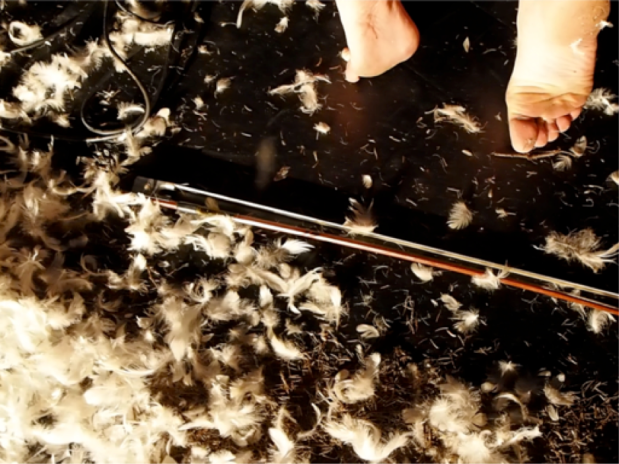 From rehearsals, NTA 2015 Photo Gunhild Mathea Olaussen
From rehearsals, NTA 2015 Photo Gunhild Mathea Olaussen
Text base
In addition to the poem “Skinismål”, the text used in Territorium is of an immediate subconscious nature. Sound from the aforementioned inner voices from my past is performed untreated, as a direct stream of sonic recollection. I also use phrases from my own stream-of-conscious “non-sense” poem “Omlingen sangle,” I wrote this piece while traveling to a distant place, as a direct response to the sensation of being alone in a strange and unfamiliar world. Searching among these written words to find a familiar ground. The creative method that forms the basis of this poem is often referred to as automatic writing, or free association, a method that, according to “MoMa learning” has been widely used to bring out unconscious thoughts of the one who writes, since the beginning of the Surrealism movement. (Around 1920 and beyond.) (https://www.moma.org/learn/moma_learning/themes/surrealism/tapping-the-subconscious-automatism-and-dreams Accessed May 11. 2017)
“Omlingen Sangle”
Kangle sangles vin om vita vert skula
Kangle sangles vin
om ruva et fang
Fallna vert mulvene
Margo vert skrull
Mingen sangles om vita vert mull.
Kangle vin skrulla
vert omlingen sangle
Balvit inga nåle, kullruva lång
Friline malvinett gomle lett måld
gurlite sangles vin.
Lita vert gulln (Elle 2013).
Lastly, for the ending of Territorium, I sing parts of a poem I constructed from my favorite word (apple)–translated into 14 languages, and then treated through a markov chain-based text-generator, re-distributing the letters and words. Here the single word eple expands in excess of itself, becoming more than the meaning of the word; or rather, other than the meaning the word itself. An abstraction of the word, a stretching of its functionality through manipulation, interpretation, and musicalization.
“Afal”
Ja moma mas
Pom Macel
Po m me mas
Po ja Eplka m pppplko mapel
Jas
Polm
Pomapple
Jablmome anza mukape
a pla mablma a Ma melkomanana
elë ma Ma Mabumo
mo a masa
el mo elale
muko pl Eppelë
Ma Mabuko Mas
Jana mafanaple
Jaceira pelelle (Elle 2014).
Although Territorium is rooted in textual material, my vocal performance to a large degree consists of non-lingual sounds. The vocal sounds in the piece are rootless, picking up from the traces or the debris of lingual sounds, from words and crumbles of words, from melodic fragments and textures. An inaccurate sweep through history of diverse traditions, and cultures, in connection to an internal journey through archived pieces, imprints of memories and dreams. In the performance situation I am attempting to make space for moments where I may let the imprints of sounds, words and visions stand up to form a state of flow, and as such to let the subconscious mind speak. As stated in the following quotation from “MoMaLearning” at the Museum of Modern Art´s website in New York, accessed on 11 May 2017:
Surrealists were also deeply interested in interpreting dreams as conduits for unspoken feelings and desires. The works explored here did not begin with preconceived notions of a finished product; rather, they were provoked by dreams, or emerged from subconscious associations between images, text, and their meanings.
More than using the text as such to create the sounds I am through this performance attempting to express embodied experiences through vocal and instrumental sonic storytelling. Let the sound of the voice be the material, rather than carry the textual material. Let the sounding voice be performative, be the action, be the sounding materialization of stories, of confusion, and defeat, and wonderment, and desires. Meredith Monk, one of the pioneers of extended vocal techniques, and a significant carrier of the tradition of “non-verbal vocal sound that lay beneath and beyond language” (Arta Records – 2HP Productions 2017), significantly informs the field were Territorium operates. According to Jowitt:
Whether presenting epics like Quarry (1975) … Atlas (1991) small musical theatre pieces like The Platau Series (1978) and Facing North (1990) or solo vocal recitals, Monk remains firmly situated in the bardic tradition. Her forms may be wholly contemporary but her images, her voice and her themes resonate with the power of myth and legend (Jowitt 2011).
Stage and objects
When the audience enters the performance space in Territorium they enter directly into something that could be perceived as a plotted territory. A space defined by fragments of objects, pine needles, soil and feathers, organized in circular formations opens up. A volatile mandala of tracks, collections of items and materials. According to Carl Jung the mandala reflects the diversity and integrity of the person who creates it; it is a symbol of the Self. The Swiss thinker goes on to state that “mandala means circle. Their basic motif is the premonition of a center of personality, a kind of central point within the psyche, to which everything is related, by which everything is arranged, and which is itself a source of energy’’ (Jung 1981).
In his article “Mandala – Sacred Geometry in Buddhist Art,” published on www.exoticindiaart.com in September 2000, Nitin Kumar writes:
Perhaps the most admired and discussed symbol of Buddhist religion and art is the mandala, a word which, like guru and yoga, has become part of the English language. Its popularity is underscored by the use of the word mandala as a synonym for sacred space in scholarship world over, and by its presence in English-language dictionaries and encyclopedias.
The creation of, and the symbolism associated with the mandala has a particularly long history, and is important for a number of cultures and religions, with links to rituals and religious practice, particularly outside the Western world.
The visualization and concretization of the mandala concept is one of the most significant contributions of Buddhism to religious psychology. Mandalas are seen as sacred places which, by their very presence in the world, remind a viewer of the immanence of sanctity in the universe and its potential in himself. In the context of the Buddhist path the purpose of a mandala is to put an end to human suffering, to attain enlightenment and to attain a correct view of Reality. It is a means to discover divinity by the realization that it resides within one’s own self. In the Rig Veda and its associated literature, mandala is the term for a chapter, a collection of mantras or verse hymns chanted in Vedic ceremonies, perhaps coming from the sense of round, as in a round of songs. The universe was believed to originate from these hymns, whose sacred sounds contained the genetic patterns of beings and things, so there is already a clear sense of mandala as world-model (Kumar 2000).
Studies of the mandala as a symbol and phenomenon are a huge field, which I do not delve at length into in my work. Yet I choose to refer to some of the historical meanings of the mandala because I perceive it as relevant to the construction of Territorium. First, as a historical backdrop for the formation on stage: space is defined by fragments of objects organized in circular formations; a plotted “territory” that the public will or will not want to treat with some caution and respect, due to the fact that one sees that it is fleeting, and that it is prepared with thoughtfulness. The audience is given no instructions on where to go or sit, the room has no chairs. Thus the audience is already forced to break up the structure of the mandala as they enter, in the moment they are coming in to the space. Next, they choose perspective for what will happen next. Their room for maneuver and action are the same as for the performer–provided that the performance is played in its original configuration–with the audience at the same level as the performer, at the stage. In some of the performances of Territorium, such as in an amphitheatre, audience members look onto the stage.
Territorium´s mandala is constructed of goose feathers, pine cones, twigs, sticks and needles from pine trees. These materials are personal symbols for my restlessness and rootlessness, along with tracks from a geographical and emotional attachment to my home ground, the landscape of the deep pine forests from where I grew up. The use of symbol-heavy references also relates to how I build my musical voice. Through a ruthless quest for sonic treasures, regardless of time and tradition I collect, compose, and re-assemble textures, timbres, lingual peculiarities, and melodic surplus, from a world of sounds. Whether I know the aesthetics through years of study, or whether it is based on newly found material through a dream state, I let the materials have equal right to be part of my expression.
On stage but off center a sculptural stringed instrument of steel, wood and piano strings is placed. An instrumental body enclosing me, the performer, when I move into it. The shapes of the instrument may be reminiscent of ribs or wings. The instrument serves as an extended mouthpiece, an innermost territory, alongside with the voice and the electronic processors.
Black projection screens are hanging in four directions in the room, framing the mandala. Here, the performance’s filmed material appears as an integral part of the performance. So the audience can choose whether they want to focus on the performer on stage, on film or in combination. Whereas the film can hold more concrete external action, the present performer carries an expression of an inner action. As exterior and interior.
 From the filming of Territorium in Fredrikstad 26th November 2016. Photo: Janne Hoem
From the filming of Territorium in Fredrikstad 26th November 2016. Photo: Janne Hoem
The filmed material
The material that appears on the screens has been recorded and developed in parallel with the musical and conceptual material. It has always been my desire to let the visuals, the film and space be integrated, to become part of the musical and physical material, thus the filmed material has been treated musically throughout the process. The film does not have a linear narrative; it appears rather as fragmentary memories, actions and dream visions. We have been searching for a rhythm, and an energy, which may put me as a performer – as well as listening audience members – in a state of presence, where mental images are allowed to arise. We have a desire to meditatively expand time, and fill the spaces. – Listen, observe and recreate. By revealing the layers and letting them appear in all its formations, the material of the film – as in the material of Territorium as such, serves a personal acceptance of a fluctuating soul. Through awareness, presence and sincerity we aim for relevance for the listeners, beyond the purely personal as such for the performer.
Movement studies in Japan
In search for an awareness, and an imagination beyond time and space, and in the search for a connection between a free (extended vocal based) embodied voice and bodily movement, I was drawn towards the aesthetics and ideas of early Japanese Butoh. Since this body-based performance form has been described in various ways, I here quote the Wikipedia description, most recently accessed on December 2nd 2016.
“Butoh” (舞踏 Butō) is a form of Japanese dance theatre that encompasses a diverse range of activities, techniques and motivations for dance, performance, or movement. Following World War II, butoh arose in 1959 through collaborations between its two key founders Hijikata Tatsumi and Ohno Kazuo. The art form is known to “resist fixity” and be difficult to define; notably, founder Hijikata Tatsumi viewed the formalisation of butoh with “distress”. Common features of the art form include playful and grotesque imagery, taboo topics, extreme or absurd environments, and it is traditionally performed in white body makeup with slow hyper-controlled motion. However, with time butoh groups are increasingly being formed around the world, with their various aesthetic ideals and intentions.
From watching videos of butoh performances by Tasumi Hijikata, Min Tenaka, Kazuo Ohno and Yoshito Ohno, I was deeply fascinated by the power of these performers` presence: their ability to express life and humanity, to embody the music and sound of their performances. Janne Hoem and I started to talk about how Butoh, in its early forms, seemed to inform our aim for Territorium. Both speak to an audience, and aim to make sense beyond cognition. As my texts may be embodied and take form as abstract sounds, Butoh seemed to be a movement or an art form deeply investigating the expression of embodied text, and expressing the subconscious mind.
Together with Hoem, I studied butoh at the Kazuo Ohno Dance Studio in Yokohama, Japan over one intensive week with Yoshito Ohno, the son of the founder. Although the training was a short period, this was a precious experience for me. Through the supervision of Mr. Ohno, I found a stronger connection to my subconsciousness, or perhaps what could be described as my soul. Within my work, as I mentioned, I question aspects of gender. I have always been in opposition to many gender-based expectations. Through my voice, my musical compositions, and theatrical work, I have been searching for fluidity in this matter. In butoh, both aesthetically and in the philosophy behind it, I found grounding for a freedom related to gender identities. A Swedish writer on the subject writes that the “desire for originality, the exploration of paths towards it, and the attention paid to obstacles that have blocked the way to the memory, is a constant in butoh;” and that this performance form “wants to transcend the identity of the sex” (Bergmark 1991).
Although Territorium does not include Butoh dance as such, this period of training with Ohno became significantly important for the development of the performance.
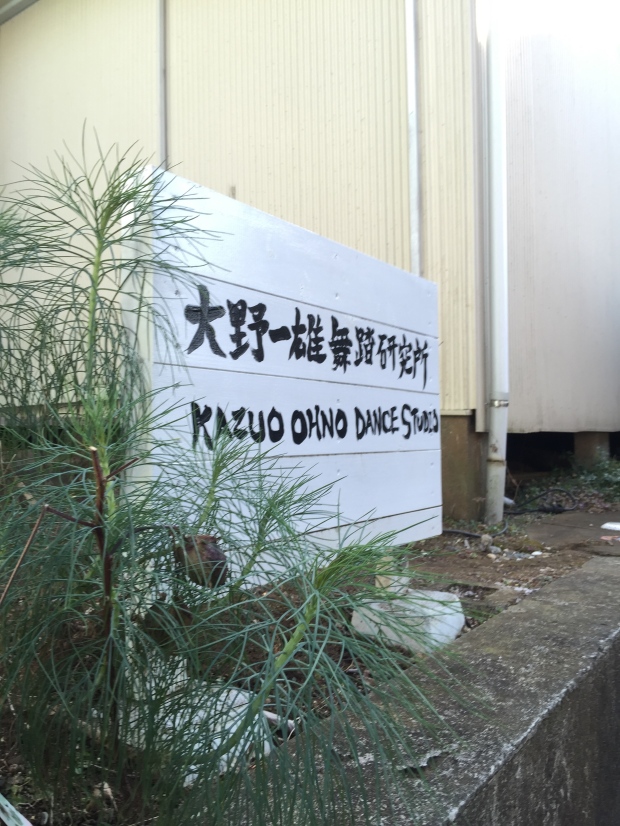
 At Kazuo Ohno Dance Studio working with Yoshito Ohno Photo: Øystein.Elle and Janne Hoem
At Kazuo Ohno Dance Studio working with Yoshito Ohno Photo: Øystein.Elle and Janne Hoem
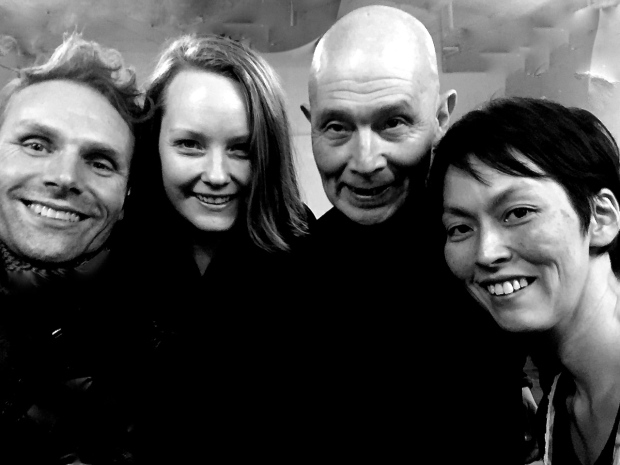 Kazuo Ohno Dance Studio. Jaunary 2016. Ø.elle, J. Hoem, Y. Ohno, M.Mizohata. Photo: Keiko Ohno.
Kazuo Ohno Dance Studio. Jaunary 2016. Ø.elle, J. Hoem, Y. Ohno, M.Mizohata. Photo: Keiko Ohno.
Pitfalls and difficulties and failures
With Territorium I wanted to make a rather simple solo performance in collaboration with visual artists, unifying what is seen with what is heard within a live performance. I would allow myself to be poetic, not using humour as a method, and not using trash as an aesthetic. These were not rules useful for creating a concept, rather verbalized reminders for what I wanted to do.
The more we worked on the project the more we realized that it was becoming increasingly complex. Articulating what Hoem, Oluassen, and I wanted Territorium to be proved exceptionally elusive. The desire to tell embodied stories, express abstract and concrete mind visions, and avoid comprehensible text deliverance, collided with the fact that we continued to use “Skirnesmål” in its entirety. Keeping this Icelandic poem throughout the process created some antagonisms. The poem is well known, and by having the poem read as a whole in the beginning of the performance, I was making it difficult for anyone experiencing Territorium not to conclude that my performance was an interpretation of the text. After viewing a performance of Territorium, Associate Professor Claire Hind at York University wrote, “there seemed to be an inner narrative that we could not gauge fully, I am a great believer in ambiguity – but ambiguity does not mean never not knowing. …You seem to be hiding something so coded we are left slightly confused” (Hind 2016).
The excess of materials, some of rather heavy symbolic matter, ultimately created a challenge. How to provide a way for the audience to navigate in this density of expressions? How to not let the poetics of the different material–scenography, sound, film, text, body, personal symbol–drown the totality of the performance experience.
It has been a challenge to describe the performance in programs and descriptions. For the premiere performance at Tou scene in Stavanger, as well as in the program for the festival festival “The House and the Lights” in Fredrikstad, I wrote:
Territorium – a Visual Concert Performance by Øystein Elle. In the making of the piece the artists behind Territorium have let themselves be inspired by Japanese Avant Garde, Norse mythology and European Dadaism. Parts of the process of making the piece took place in Tokyo. Through the construction and deconstruction of roles, identities, personal and social space, territories; this piece is circling around our relationship to our own conventions. The ensemble invites to a collage, a room where “sense” and “non-sense» is equated, and the different elements possess equal roles in a musical polyphonic whole (Elle 2015).
I am trying to be open, yet give a direction on what I think the performance is. However I see that the sentence “Through the construction and deconstruction of roles, identities, personal and social space, territories; this piece is circling around our relationship to our own conventions” (Elle 2016) might point at aspects that could be hidden, or non-existing for audience members.
Still it was more open than the following citation from an earlier description I wrote for the project: “The project “Territory” discusses roles, status and expectations related to gender, origin, social and geographical background. Through a poetic and somewhat abstract language, we are facilitating for reflection linked to universal and relevant themes” (Elle 2015).
Possibly I should let future descriptions of Territorium solely describe the form, and thus let the interpretation and the construction of “meaning” happen in the experience of the viewer. Let each person draw their own conclusions in their meeting with the content–the music, the footage, the space and the symbols.
The performance has been performed in two different configurations. The original setup has audience and performer in the same space, as described above in the paragraph “Space and Objects”
When performing it in Tokyo in June 2016 and in Fredrikstad September 2016 we chose to change to a traditional amphitheater configuration. The film appears as a backdrop, and the audience is looking down at the performer, rather than being together with the performer, sharing the same space, exploring simultaneously. The choice of performing Territorium in this configuration was based mostly on the fact that it makes it more touring/travel friendly, and that it makes it less resource demanding for the theatres and festivals. In retrospect I see that this change makes a bigger difference for the experience of the piece than I might have reflected upon in advance.
Reactions and quotations from audience
More than I could imagine, the amphitheatrical performance Territorium seemed to communicate to a Japanese audience. After the shows, a big crowd, more than half of the audience members stayed for Question & Answer sessions, lasting for 1,5 – 2 hours. They wanted to express the inner journeys they went through from experiencing the performance. They expressed revisiting spaces, happenings, and encounters in their lives; and before birth “earlier lives”.
“In CAPTO MUSICAEs performance of Territorium I found splendid figures, expressions and words. They still remain in my eyes, ears, brain…all my senses very intensely. I appreciate this.”
–Misako Ueda, artistic director of Theatre Xcai in Tokyo, Japan.
“Mr. Elle is an unique performer, or even a dancer, since music is embedded in his heart and body unlike many dancers who just use music as the accompaniment to their dance. His performance is “dance of recollection” as he unfolds his memories of music within him.”
–Yoshito Ohno, Butoh dancer and choreographer, owner of Kazuo Ohno Dance Studio.
“…His performance takes us to the realm of mythology. It is a journey to the source of life.”
–Mina Mizohata, assistant to Yoshito Ohno.
“The performance of Territorium made us think that Øystein Elle was just visiting this Earth. There was a music, or just a voice which is a secret to me. His playing of music, singing and moving, was all there for calling and remembering. He is stepping in to the forest. Is it our ground? Is there a way back?”
–Neiro Mime, Japanese dancer.
After performing Territorium in Fredrikstad I got reactions of a very different nature than from the Japanese audience, but no less valuable. To put the difference in very rather general light, I might say that whereas the Japanese audience seemed to express what the performance Territorium made them feel, the Western (international) audience at the festival in Fredrikstad was expressing mostly what the performance made they think, or what they thought of the performance. Significant differences, and both of highly valuable nature in their nature for the artists.
Despite the fact that Territorium has fixed elements, and rather strict frames, it appears very different each time it is performed. Musically it is based on simple yet strictly composed elements, frames for improvisations, as well as open spaces for letting the music arise in the meeting with the performance situation. The concept allows different configurations, and the challenge is not to choose one, but to search for different ones the serves the content, and is experienced as communicative, and inviting for encounters between the inhabitants of the performance space.
I have been invited to upcoming festivals and venues with this project, and I want to keep experimenting with the format, and the content. Professor Hind gave the following idea for a future configuration of Territorium :
A space that invites an audience over a period of many hours – an open installation with you making, looping, sound, singing, developing a sonic piece, so that we see how time affects the work that you are composing. …they (the audience) could be sitting on the floor, laying down, standing, walking around, they could have their eyes closed, they could contribute to the laying of the stones, they could chose to stay for half an hour, they could return an hour later, someone may choose to stay for the whole duration, another may come back every hour on the hour (Hind November 17. 2016)
Slightly related to this idea I might be performing Territorium in a huge nest in a treetop as a long durational piece at the festival “Færder Kulturfestival” in July 2017.
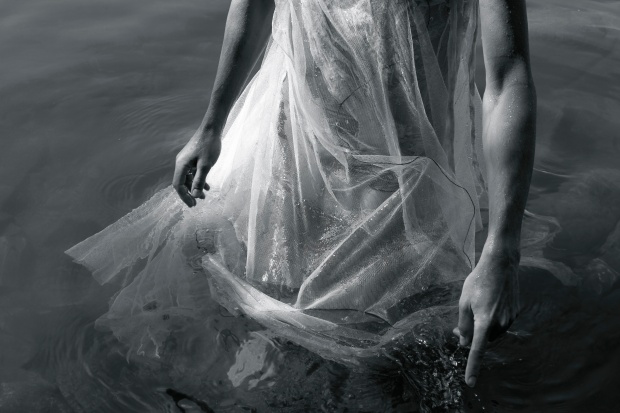 From the process of making the film for «Territorium” Photo: Janne Hoem.
From the process of making the film for «Territorium” Photo: Janne Hoem.
Territorium had its opening and subsequent performances at Tou Scene in Stavanger, Norway 17th and18th March 2016. Co-produced by NyMusikk Stavanger and Tou Scene.
Further it was performed at “The 12th international Theatre + Dance Festival” in Tokyo Japan, 24 and 25 June 2016, and at the festival “The House and the Lights” at Norwegian Theatre Academy in Fredrikstad, Norway. Further engagements in 2017 -2018 includes performances at “Færder Kulturfestival” in Vestfold, Norway and The Konservatory in San Fransisco, USA.
 Performing Territorium at Theater Xcai in Tokyo. June 2016. Photo Theater Xcai.
Performing Territorium at Theater Xcai in Tokyo. June 2016. Photo Theater Xcai.
In November-December 2017 I made a video edition of the piece Territorium. It is not a documented performance for an audience, but a performance for camera, where the camera “is the audience” invited in to “my Territorium.” As the performance Territorium is meant to happen at the meeting place with an audience, my actions, and the musical journey of the piece, and take shape through this meeting with audience members, I experience a challenge in removing that aspect in order to make a video version. Nevertheless this procedure might bring about a stronger video format than a documentation of a performance, since the audience in this case is the imagined viewer of the video.
Stuffed Camel, A Theater Sonata

The Process
Stuffed Camel is the largest and most ambitious of the productions completed during the Capto Musicae project. It was planned from the start that I would create a production with third-year students from the Norwegian Theatre Academy, and be given 6-7 weeks of rehearsal period. Originally, this performance was planned in line with an already developed concept I had made along with another artistic partner; the production was planned to be created with the acting students from the graduating year, as co-creative performers, and directed and composed through the joint artistic leadership of this partner and myself. However, at the request of NTA, these plans were altered, and I was asked to propose a new concept, with me being the sole originator of the concept, composition, and direction of the production. The resulting project became “Stuffed Camel – A Theatre Sonata”
Anders Firing Aardal, one of my former students at NTA, was immediately approached to be my assistant. In addition, NTA, as afore mentioned introduced me to Robert M. Johanson from The Nature Theatre of Oklahoma (USA), who ended up serving as a dramaturg on Stuffed Camel. The three of us developed my initial concept before the rehearsal period with the performers began. In terms of the performance text, Albert Camus´ philosophical essay “The Myth of Sisyphus” served as a central platform. Johanson, Aardal, and myself gathered many texts from an array of sources for us to consider using later during rehearsal as the basis of collage, building a foundation of textual material to use as the starting manuscript. Further, during this initial period, I also began working closely with Johanna Dalbäck, a third year student in NTA´s scenography department, to find a visual palate to integrate with the overall composition I was outlining.
Over the years, I have developed an artistic methodology that balances two distinct kinds of material. On the one hand, I seek forms to rehearse pre-created material with the performers; one the other, creating forms where the material can occur organically, during the encounter between the individuals with each other, with the theatrical space, with the scenographic objects. I am curious about developing musical, textual, and action-based content from “inside of the process”, as much as possible, rather than having too many things planned in advance. With “Stuffed Camel – a theater sonata” I wanted to investigate the baroque and classic musical form, sonata, as a vehicle for contemporary music theatre. Here is a schematic representation of the sonata form, articulated by Mark Feezell on www.learnmusictheory.net, which I accessed on August 14th. 2016. Schemes like this may appear in different variations.
| (Introduction)
· Introductions occur only once in their entirety, at the very beginning of the movement. · Not all sonata forms include an introduction |
| Exposition
First theme group (or Primary Theme) · Often (not always) assertive or dramatic in character · Tonic key typical · May end with a PAC or “dissolve” into transitional material (Transition) Second theme group (or Secondary Theme) · Typically in V if the movement is in major, III if the movement is minor · Often (not always) more lyrical than the first theme · Sometimes early sonata forms (Haydn) simply transposed the first theme for the second theme (Transition) Third theme group · Sometimes it is appropriate to speak of a “third theme” · Some authors prefer to use the terminology “secondary themes” for all themes after the first theme Codetta · Must come back in the recapitulation to be a true codetta · Typically emphasizes the key of the last theme group (usually dominant or relative major) · Lots of tonic-dominant chord progressions |
| Development
· Various motives from the introduction and exposition are explored in a variety of keys · Modulatory and unstable · Sequential, motivic, or harmonic structures often guide the development · Developments are NOT random wanderings; rather, composers use them to “work through” conflicts present in the exposition · Ends with a retransition anticipating the recapitulation’s motivic material, accompanied by a dominant pedal point. |
| Recapitulation
Normally, the recapitulation restates the themes from the exposition transposed to the TONIC key. |
| (Coda)
· Occurs once at the end of the movement, if present. Not all sonata forms include a coda. · Terminal development: Development in the coda (rare before Beethoven) · To find the coda, compare the recapitulation and the exposition measure-by-measure until all material from the exposition has been stated. The remaining music is the true coda. (Remember also: “Once a codetta, always a codetta.” The return of the codetta is part of the recap.) |
Stuffed Camel is quite strictly composed after the principles of the sonata, consisting of three movements: A (Exposition) – B (Development) – A2 (Resolution) + Coda (which means tail). Each movement in Stuffed Camel is assembled following these musical rules which span more than 200 years, with main theme, side theme, variations over a theme, and codettas. (“small tails”).
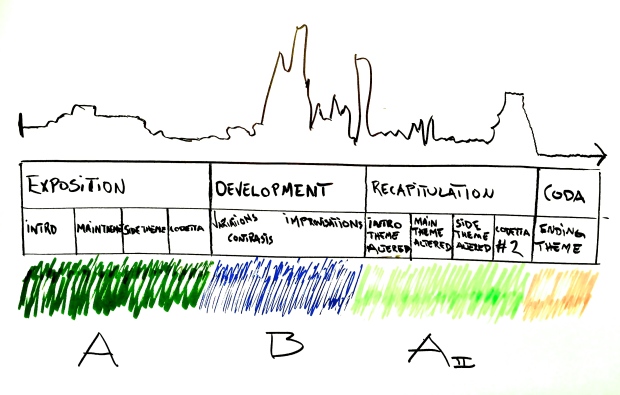 My graphic representation of the sonata form as it has been followed in Stuffed Camel.
My graphic representation of the sonata form as it has been followed in Stuffed Camel.
I am exploring possibilities for cross-disciplinary music-theatre, using extended vocal praactice as the primary compositional tool. An important goal for me is to create musical, sonic, and visual performance projects, as well as to develop methods in which texts, sounds, and scenic / kinetic elements can come together as equivalent elements in live theatre.
In the process of making this piece I worked closely with the performers, as well as with an artistic team. Before and during the rehearsals we investigated many of my research ideas, experiencing large sources of inspiration, methods, and techniques.
As stated above, Stuffed Camel´s textual starting point was “The Myth of Sisyphus,” where Camus introduces his philosophy of the absurd:
Much of our life is built on the hope for tomorrow, yet tomorrow brings us closer to death, the ultimate enemy; people live as if they didn’t know about the certainty of death. Once stripped of its common romanticism, the world is a foreign, strange and inhuman place; true knowledge is impossible, and rationality and science cannot reveal the world—such explanations ultimately end in meaningless abstractions and metaphors (Camus 1942, English translation 1955).
The manuscript for Stuffed Camel combines material from various sources. Using Camus´ essay as the underlying thread, we created a collage drawn from multiple kinds of text: transcribed and reworked elements from TV-Shows; conversations from WBAI radio station in New York, information from each actor´s Facebook-walls; texts found on the web in the public domain; and excerpts from several pieces of fiction.
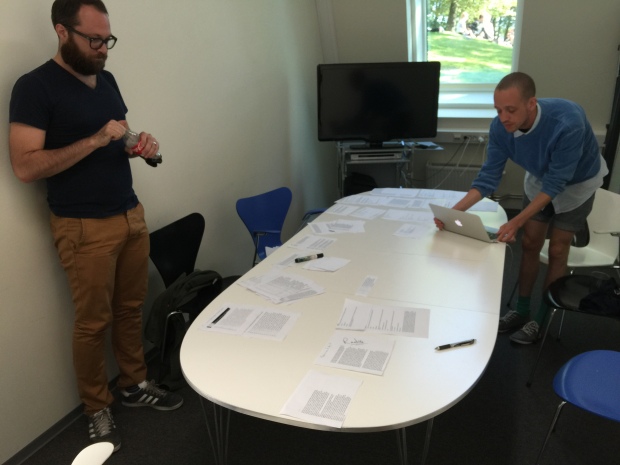 Photo: Robert M. Johanson and Anders Firing Aardal at our first text-collage workshop
Photo: Robert M. Johanson and Anders Firing Aardal at our first text-collage workshop
Stuffed Camel lacks a central character or hero, and the piece does not contain one narrative. The play is a polyphony of voices of characters who inhabit the performance space. They are put in the same and alternate situations, and collectively or individually make comments, follow their own path, coexist, but never leave the common ground. They observe themselves and each other. The way the participants /performers in Stuffed Camel co-exist and represent a multitude of voices relates to Mikhail Bakthin’s notion of polyphony, of carnival and the carnivalesque. The polyphony of voices is apparent both in the nature of its textual composition, where individual voices give in to a polyphony of vocal utterance; as well as material from writers and pop cultural voices originating in different times, contexts, and media, united in a staged situation through the conveyers on stage.
The stage, which may be seen as a provisional ‘garbled backyard’ filled with trashed furniture, garbage and instruments, has its own polyphony. It functions as the premises, the area of movement and the action for those who inhabit it. The performers’ relation to each other, and to life, unsuppressed by norms, law or order, is reminiscent of Bakhtin’s notion of carnivalesque. According to the author:
Carnival is a pageant without footlights and without a division into performers and spectators. In carnival everyone is an active patricipant, everyone communes in the carnival act. Carnival is not contemplated and, strictly speaking, not even performed; its participants live in it, they live by its laws as long as those laws are in effect; that is, they live a carnivalistic life. Because carnivalistic life is life drawn out of its usual rut, it is to some extent “life turned inside out” (Bakhtin 1984).
In Stuffed Camel the characters on stage are speaking for themselves, yet also together and at the same time as the other participants on stage. They interact with and without words exempted from normative terms for dialogue. “A single person, remaining alone with himself, cannot make ends meet even in the deepest and most intimate spheres of his own spiritual life, he cannot manage without another consciousness,” Bakhtin continues. “One person can never find complete fullness in himself alone….Carnivalization, in addition, makes it possible to extend the narrow scene of a personal life in one specific limited epoch to a maximally universal mystery play scene, applicable to all humanity” (Bakhtin 1984).
In most of my theatrical and musical work I rework textual material. Either I write the base material myself, or I use existing material. Influenced by groundbreaking writers such as the Dadaist Tristan Tzara, and the avant-garde artist William S. Burroughs, I use classic chance-methods such as cut-up techniques, as well as searching for and developing new techniques. In the process of making Stuffed Camel we experimented with and used a number of methods to rework, and to musicalize the text. We used everything from classic techniques to our own, newly developed ones.
I believe, if we as a performers and creators can un-ground our voices from conventions connected to textual deliverance, we will then have infinite possibilities for textual interpretation onstage. Then we can discover an experience of reception from the audience that goes beyond cognitive limitations. As one author has noted, “Dada valued cacophony, dreams, drugs, and the violation of syntax as techniques for freeing the unconscious from the domination of reason and tradition” (Lewis 2007).
A number of techniques were used in the process of making the textual script of the theatrical work, Stuffed Camel. Traditional cut-up and algorithm-based techniques alongside with contemporary techniques were developed for the Stuffed Camel process. These include: Vowel removal, Smartphone selection, Unruly text to speech misunderstandings, Google confusion translation,Cut up techniques, Forced memorization, Non-sense random word generators, and Algorithm based methods.
In addition to shaping text through these methods, paragraphs were taken from the sources, and performed as they appear in their original form. However by cutting out both smaller and more extensive text fragments from prose books, TV-shows, radio programs, all of these parts are in fact cut-ups, put together in the manuscript. Cut-up techniques were used on both micro and macro level in the making of Stuffed Camel. As Burroughs affirms:
All writing is in fact cut-ups. A collage of words read heard overheard. What else? Use of scissors renders the process explicit and subject to extension and variation. Clear classical prose can be composed entirely of rearranged cut-ups. Cutting and rearranging a page of written words introduces a new dimension into writing enabling the writer to turn images in cinematic variation. The cut-up method brings to writers the collage, which has been used by painters for seventy years (Skerl 1986).
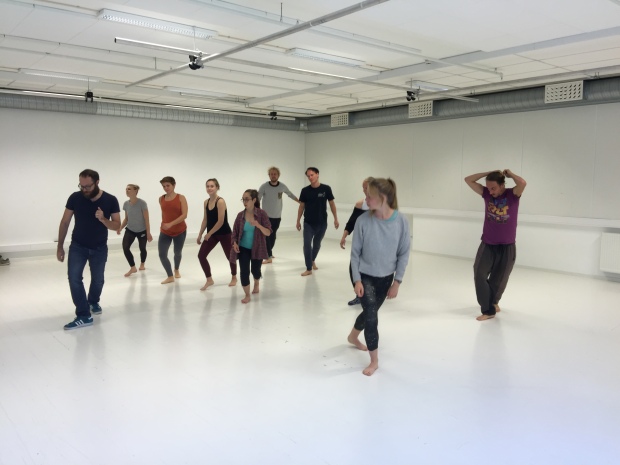 First rehearsal day. Working on choreography by Robert M. Johanson. Photo: Øystein Elle
First rehearsal day. Working on choreography by Robert M. Johanson. Photo: Øystein Elle
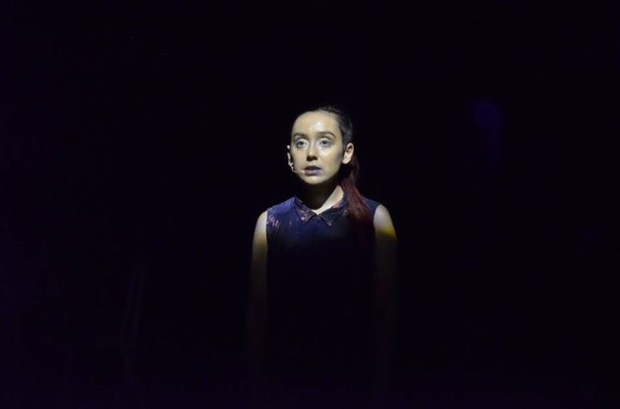 Viola Tømte performing a monologue with all vowels removed. Photo: Øystein Elle
Viola Tømte performing a monologue with all vowels removed. Photo: Øystein Elle
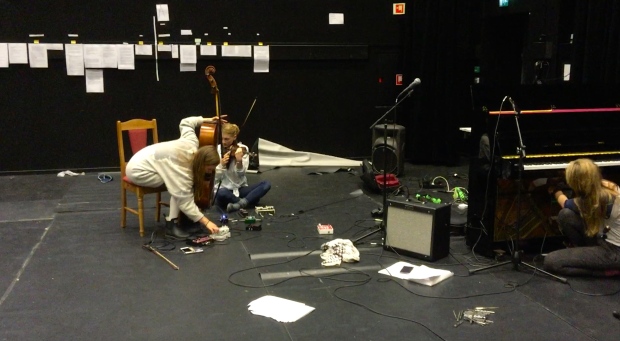 Performers rehearsing prepared piano, violin and cello run through noise devices. On the back wall we see parts of the (cut up) manuscript. The different cuts put up to be arranged and re-arranged. Photo: Øystein Elle
Performers rehearsing prepared piano, violin and cello run through noise devices. On the back wall we see parts of the (cut up) manuscript. The different cuts put up to be arranged and re-arranged. Photo: Øystein Elle
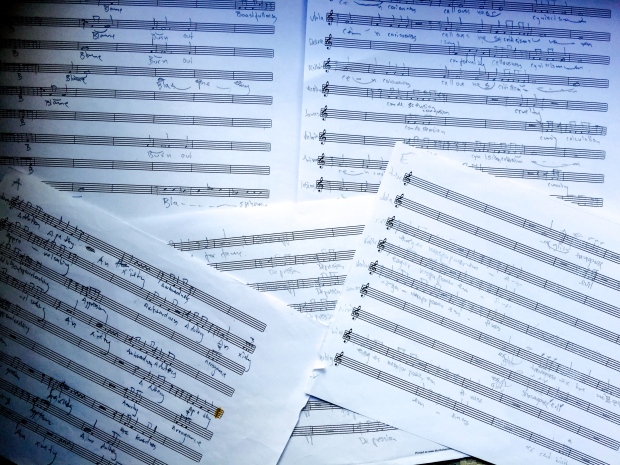 “The list of Vices” A 9 part speech choir composed from an alphabetical selection of the actor’s personal vices in life. Photo: Øystein Elle
“The list of Vices” A 9 part speech choir composed from an alphabetical selection of the actor’s personal vices in life. Photo: Øystein Elle
Musically Stuffed Camel spans noise textures, through fragile melodic structures, and complex rhythmic structures to punk rock. I used the classic ensemble, piano trio (Piano, Violin and Cello) as a recurring band. Partly because of the expectations this “band” creates by the look of it, and also for these instruments applicability as noise instruments breaking the sonic expectations of the spectator
Influenced by pioneers in composing for, and with non-specialized musicians, such as the aforementioned Wolff and Oliveros, I wanted to test how and if I could compose and instruct musical structures for an ensemble of actors without compromising in terms of musical quality. I wanted to test if the artistic voice of the performers rather could be experienced as an added value of the musical result.
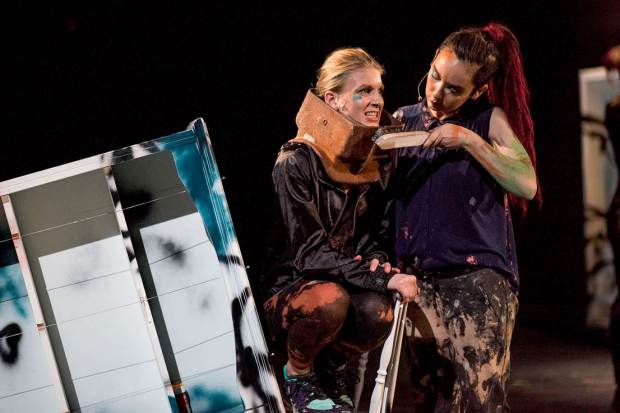 A double purpose object, visual as well as a musical function. Photo: Bård Halvorsen.
A double purpose object, visual as well as a musical function. Photo: Bård Halvorsen.
The performance
 Opening of «Stuffed Camel – A Theatre Sonata» October 2015. Photo Bård Halvorsen
Opening of «Stuffed Camel – A Theatre Sonata» October 2015. Photo Bård Halvorsen
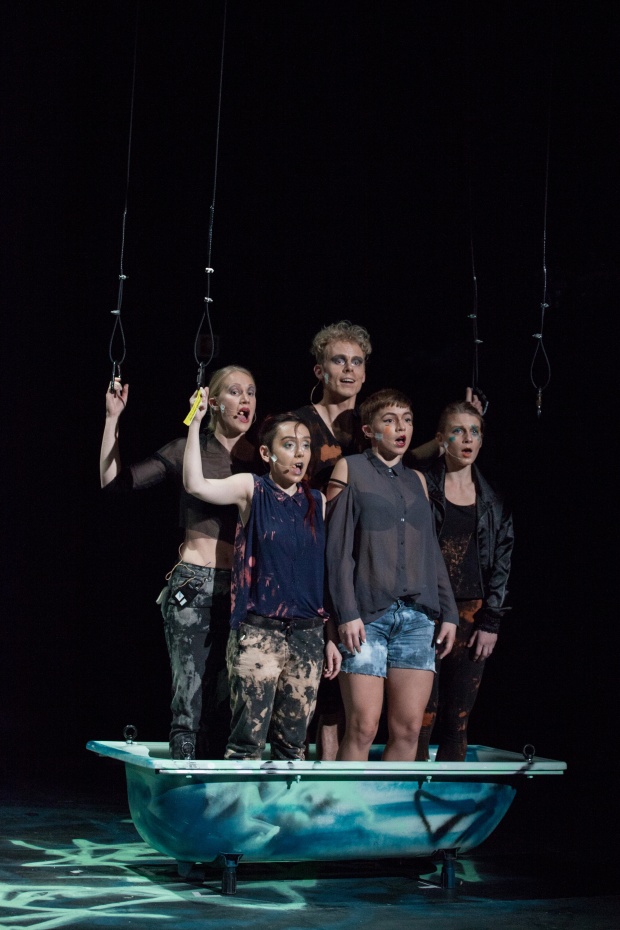 Opening of «Stuffed Camel – A Theatre Sonata» October 2015. Photo: Freya S. Hestnes
Opening of «Stuffed Camel – A Theatre Sonata» October 2015. Photo: Freya S. Hestnes
The textual performance in the show was delivered by the actors in an equal balance between extended vocal techniques–such as growling, inhaling, distorting, screaming, intersections between speaking and singing–and conventional speaking and singing techniques. In addition to textual passages delivered through physical movement.
The actors play all the musical instruments in the piece, consisting of cello, piano, violin, electronic noise devises, 70th living room organ, brass plates, music boxes, bass guitar, electric, guitar, the stage set, and sounding smartphones.
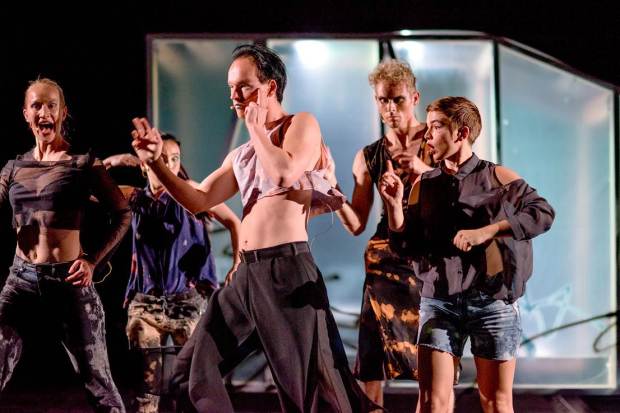 The performers dancing a text from “The myth of Sisyphus” Photo: Bård Halvorsen
The performers dancing a text from “The myth of Sisyphus” Photo: Bård Halvorsen
The side theme (a text from “The Myth of Sisyphus”) in the first movement of the sonata Stuffed Camel was delivered through storytelling choreography. The smartphones were used in the third movement, (in the A2 section of this A-B-A2 form) and served two purposes. First, the scene mirrors the side theme in the first movement, the dance. I had all the actors individually record the text monologue in stylized voices, and then the voice recordings were tweaked and transformed and uploaded to their smartphones to be played off simultaneously. The smartphones move with the actors in the space while they perform a twisted version of the storytelling dance from the first movement. Second, the sounding smartphones relate to the iconic piece by John Cage, “Imaginary landscape nr.4” (1951), a piece for 24 performers on 12 radios played off related to notation, with whatever was on the radio at the moment.
The next theme in the piece is a transcription of a conversation between John Cage and Morton Feldman, in which they talk about the piece “Imaginary landscape. nr. 4,” among other themes. But in Stuffed Camel, we consciously do not mention the source of the piece itself, or reveal who is talking.
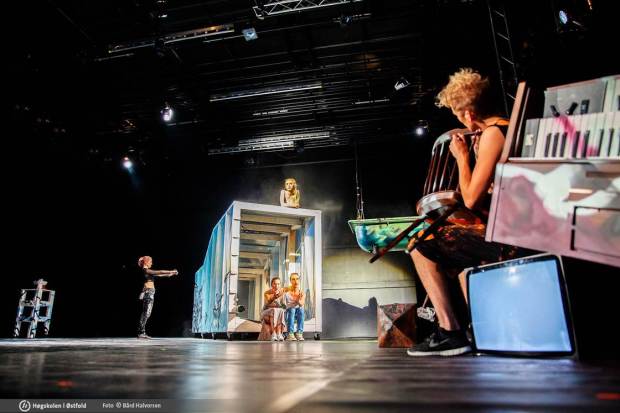 The ensemble performing a transcription from a conversation from a radioprogram. Photo: B. Halvorsen
The ensemble performing a transcription from a conversation from a radioprogram. Photo: B. Halvorsen
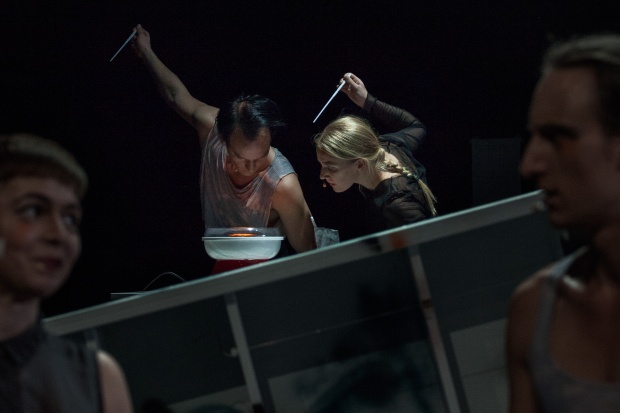 Photo: Freya S. Hestnes
Photo: Freya S. Hestnes
In the photo above, two actors are performing two different versions of the same text; a transcription of a passage from the TV show “The Bachelor” (the actors in the back are making cotton candy)
An extract from the original text:
M- We are recreatin-
W- Why are we doing this
M- Do you minding sitting here//or are you comfortable
W- Ha ha ha ha…this is fine
M- How are you?
W- I’m doing well
M- Yeah?
W- I’m doing well…yeah…
M- I’ve wanted to talk to you. I’ve missed you badly (Elle 2016)
The same extract in the second version, this time treated through a chain of Google-translations:
M-We are a new production
W-Why we do this To pay attention
M-them who sit here,//Or are comfortable you
W-ha of ha of ha of ha … this is fine
M-How are you?
W-I am good
M-Yeah?
W-I am good … yeah …
M-I wanted with you to speak. I have missed them strongly (Elle 2016).
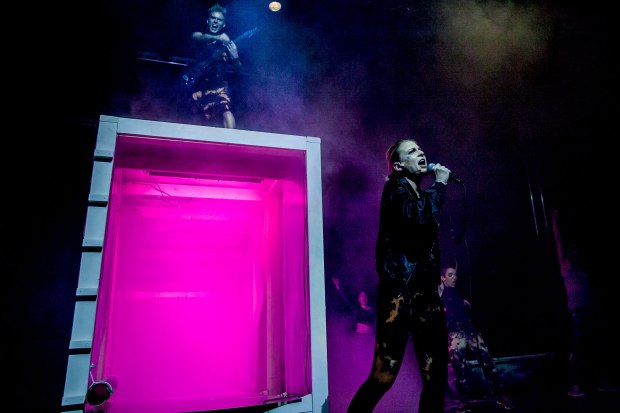 The ensemble of Stuffed Camel performing a punk song, screaming out the recipe of the worlds largest meal, (Stuffed Camel) and facts about a particular Barbie doll. Photo: Bård Halvorsen.
The ensemble of Stuffed Camel performing a punk song, screaming out the recipe of the worlds largest meal, (Stuffed Camel) and facts about a particular Barbie doll. Photo: Bård Halvorsen.
Just as I was directing the piece as a musical composer, I am investigating how I can conduct the performers as musicians no matter if they are speaking, singing, brushing teeth or making out. In Stuffed Camel the actors are onstage at all times, as members of a both theatrical and musical band. It is a composition partly based on the musical sound potential of the theatre. According to Kendrick and Roesner:
In the theatre, sound is never pure music. Rather, and to its great credit, it is impure music. It is still steeped in what its public embodiment precisely seeks to conceal: the physicality of the performers, the unforeseeable circumstances of the performance, the listeners’ more or less noisy and physical attention. To this must be added everything else: the visual setup, the acting, the improbable ballet of bodies in motion. This fortuitous symphony of bodies, of shapes, colours and lines gives sound its colour and its identity; it welcomes all sounds, all noises, and shows them around, an air that was not (be)foreseen, nourishing it and causing it to penetrate, as if breaking and entering, the fictional and personal universe of each viewer (Kendrick / Roesner 2011).
My artistic urge to thoroughly include my historical grounding–the baroque, the Dadaistic, the avant-garde, the punk/post punk aesthetics–both creates limits and freedoms in my creative process. I am searching for a balance between being true to my sources, to communicate, and to open up my work to the viewer. It is important for me to use historical elements beyond just quoting or paraphrasing; I aim to communicate with an audience, and they do not necessarily know what for instance a sonata form is. And when I include black and white films on old TV- screens on stage showing the performers in situations like eating screws, or winking with one eye, for several minutes in close up, it is to include the legacy of Dadaism and surrealism in a contemporary art piece. Does the audience have to know the historical sources in order to read or understand the work?
The actors shooting short film sequences to be shown on multiple TV-screens in the show, as a part of the scenography. Photos: Øystein Elle
Since I work with the relationship between the baroque aesthetics and the Dada, punk, trash and avant-garde aesthetics, and are thus bridging elements from a timespan of more than 300 years, I am aware of the challenge of not getting lost in the excess that this elements creates.
Stuffed Camel – A theatre Sonata, had its opening October 15th 2015. Subsequently the show was staged with mostly the original cast, and performed in Oslo, at my own festival “Sonic Harvest” in the venue Grusomhetens Teater, in October 2016.
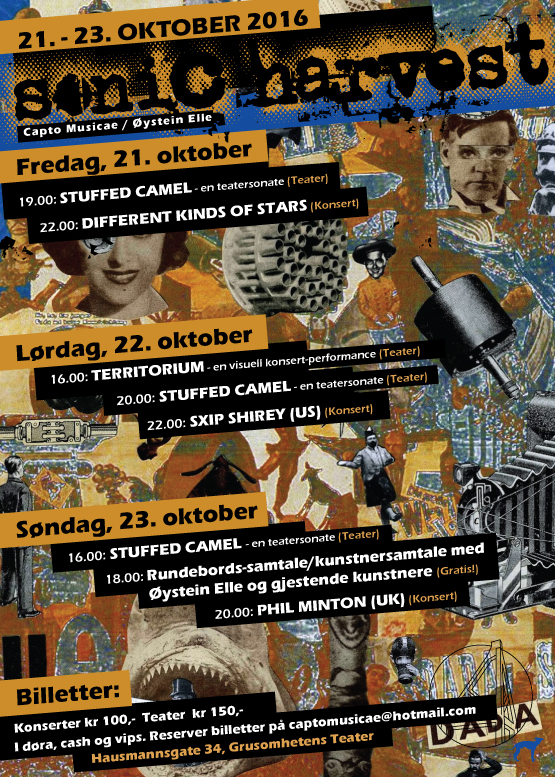
The poster for the festival “Sonic Harvest” 2016. Poster design: Paul Brady / Webverket.
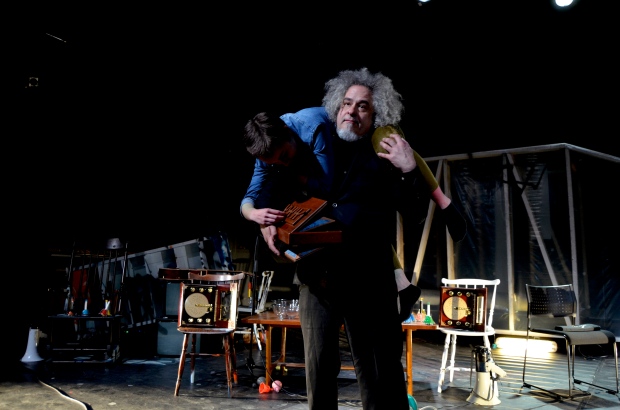 Sxip Shirey at the festival «Sonic Harvest» performing a late night show after a performance of Stuffed Camel, while the stage set of the theatre sonata is still up. Shirey is assisted on stage by one of the actors from Stuffed Camel, Viola Tømte. Photo: Øystein Elle
Sxip Shirey at the festival «Sonic Harvest» performing a late night show after a performance of Stuffed Camel, while the stage set of the theatre sonata is still up. Shirey is assisted on stage by one of the actors from Stuffed Camel, Viola Tømte. Photo: Øystein Elle
ADDITIONAL ARTISTIC OUTCOME
Chernobyl Stories
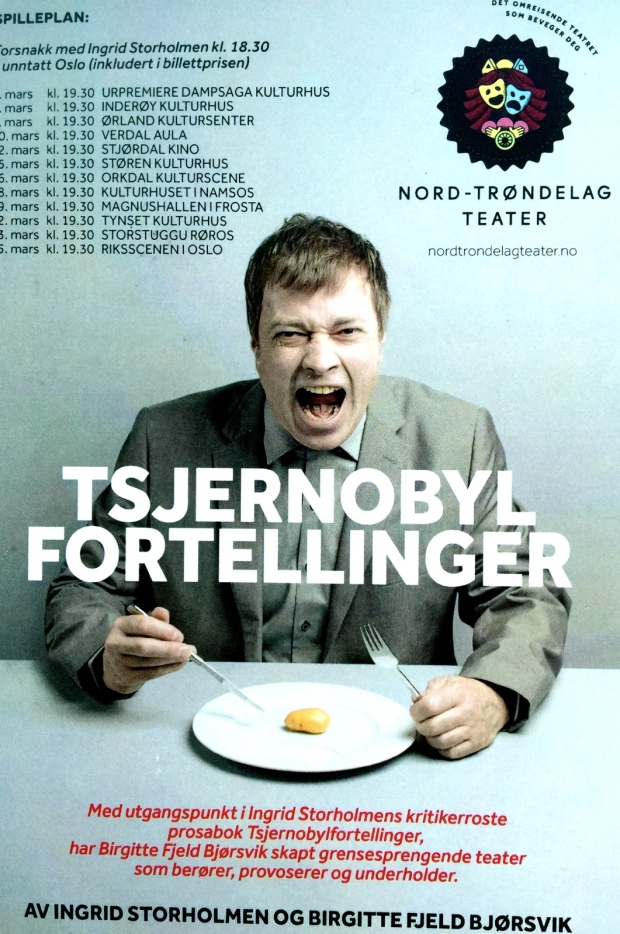
One project included in the body of Capto Musicae´s artistic research differs from the others, as I was not the initiator of the project, nor was given a task from my academic institution. The theatrical production in questions is Chernobyl Stories by Ingrid Storholmen and Birgitte Fjeld Bjørsvik, based on Storholmen´s book ” Chernobyl stories (2009. Aschehoug). Commissioned by Nord Trøndelag Teater, the play was developed and produced within a publicly-funded theatre institution, in contrast to performance work generated from the independent field. I was invited to join the project and compose the vocal and instrumental score, create the sound design, and to work as a vocal and musical instructor.
Long before I started working with the ensemble I was collaborating with the director Bjørsvik: reading drafts of the performance manuscript, as well as research material connected to the tragic nuclear accident from more than 30 years ago. In the early hours of 26 April 1986, according to the BBC News One-Minute World News archive accessed as recently as 13th May 2017, one of four nuclear reactors at the Chernobyl power station exploded. Moscow was slow to admit what had happened, even after increased radiation was detected in other countries. The lack of information led to exaggerated claims of the number killed by the blast in the immediate area. Contamination is still a problem, however, and disputes continue about how many will eventually die as a result of the world’s worst nuclear accident. I sought to compose music that could be the sound of the fear, of the wild state of mind the people close to the tragedy in Chernobyl endured. I searched for a music that would carry the severity, and threat, with dense soundscapes that could be experienced as disturbing, yet at times could open up for moments of light, the aural manifestation of a never dying hope, and a desperate humor. I wanted to make an aural materialization of the characters’ mental state.
I had no dedicated musicians associated with the production, and there was no room for including the ensemble in the purely instrumental part of the musical score. I therefore play all the instruments in the score, which consists of flutes, violin, cello, toy piano, melodica, electric bass, electric guitar, organ, scrap metal, piano, electronics (such as granular synthesis, programming drums, synthesizer, noise devices). The following example is one of the instrumental pieces I composed and performed, used as content in the performance.
The vocal part of the score was in some of the scenes performed solely by the ensemble, whereas others in a combination with my recordings. The following example is the preliminary edition of a musical section, were I perform the three voices, the prepared piano and the percussion. When performed in the play, it contains a combination of my recorded voice and instruments together with the voices of the performers on stage.
The sung text in the following example consists of an unedited Google-translation, comprised of quotations from politicians attempting to convince the world about nuclear power sovereignty. It is made for a comic-relief section in the play, where the characters make fun of nuclear power’s adverse effects. The text is then treated through and played off from electronically driven text-to-speech engines, set in languages chosen by the sound of them. The sung language is also chosen from the sound (Latvian), and not rehearsed to become properly pronounced. In the “do it yourself” tradition derived from the punk movement, I play all the instruments (Electric guitar, bass, synthesizer, sampler, programming of drums) as well as performing the vocals through megaphone. The music is composed and mixed in order to respond to my space and time based imagination towards 1980s eastern European industrial pop-rock.
In Chernobyl Stories I am investigating various ways of text and music deliverance. In the next example the characters are in a state of shock, right after the catastrophe in Chernobyl, and they witness each others sudden diseases without knowing what is happening. I wanted their bodies to speak and to sound, to let their voices and textual utterances be carried by the sound of dysfunctional breathing, and muscular tension caused by the immense fear, and desperation. The diaphragm is tensed, and they are on the border, hyperventilating, thus the words can not be pronounced normally. The choir that performs does have text, but only a few words are coming through, in a lingual sense. The words “How can we trust what they tell us?” are the words they are uttering, in the opening section coming out as restrained breath, creaks and gasps. The following video clip is a recording of the described scene.
I see working with extended vocal techniques, and the fragmentation and abstractions of text within a dramatic setting (as opposed to a post-dramatic one), as an important task–particularly in a theatre institution in the outskirts of Norway. This navigation, balancing artistic research, and production of a functional product at a small regional theater was a challenging yet fruitful experience.
The following video shows excerpts from a number of text, voice, and music-based scenes in Chernobyl Stories.
Decadence & Decay
 From rehearsals in Bushwick, Brooklyn in November 2014. Exploring materials and costumes Photo: Corentin Leven
From rehearsals in Bushwick, Brooklyn in November 2014. Exploring materials and costumes Photo: Corentin Leven
A few weeks after I started the research project Capto Musicae, I participated at a workshop in Oslo, “Alternative Paths to Opera.” This workshop gathered 14 professional singers, actors, dancers, choreographers and composers in order to investigate methods for artistic creation, and more specifically working with material connected to Kristin Norderval`s upcoming Opera production “The trials of Patricia Isasa” This was a joint investigation led by Norderval and several guest artists, including Pauline Vaillancourt, the artistic director of the opera company Chants Libres (Montreal). The Norwegian actor Morten Espeland led the “Viewpoint” classes, and the American dancer and choreographer Jill Sigman. The theme was alternative paths to opera – an exploration of cooperative methods to create new opera and new music theater. Participants worked with open form and text composition, movement, sound improvisation and physical theater using ‘Deep Listening’ and ‘Viewpoints’ – two important tools for today’s creative artists. The goal was “…to develop a common language, and working processes that will be able to renew opera stage expressions and raise competence among both creative and performing artists working with new opera.” (Norderval 2013).
My participation in this workshop was to become an important turning point for several reasons. The thorough introduction in the “Deep Listening” technique this workshop involved led to my further studies with and participation in workshops with Pauline Oliveros, the founder of the “Deep Listening Technique”. The study of her methods has had great implications for my creative and artistic activity. “Alternative Paths to Opera” also introduced another important collaboration: from this workshop experience, Kristin Norderval invited me and two other artists to be the founding members of an ever-growing union of experimental singers and composers, VoxLab, where I continue to serve on the board. Last, but not least, through this workshop I met the American dancer and choreographer Jill Sigman, as she led the physical exploration and training relating to “the Deep Listening” techniques. According to Oliveros on the Deep Listening Institute website, which I accessed on 1 May 2017:
Deep Listening explores the difference between the involuntary nature of hearing and the voluntary, selective nature – exclusive and inclusive — of listening. The practice includes bodywork, sonic meditations, interactive performance, listening to the sounds of daily life, nature, one’s own thoughts, imagination and dreams, and listening to listening itself. It cultivates a heightened awareness of the sonic environment, both external and internal, and promotes experimentation, improvisation, collaboration, playfulness and other creative skills vital to personal and community growth.
Only a few weeks later, I visited Sigman in New York, as part of a research trip. We immediately started to experiment with voice and movement in her studio in Brooklyn, especially investigating the 18th century body, the history of the castrati, and the specifics of their abnormally developed bodies. Citing Finucci, Breda states:
Beyond musical talent, the castrati arguably were equally prized for their unique physicalities. A new desire “for the unusual started to inform a semiotics of masculinity that proclaimed the…sensuality of the effeminate, the magic of the artificial” supporting their rise in popularity (Breda 2012).
 From the first days of studio research in Bushwick, Brooklyn, November 2013. Photo: Jill Sigman
From the first days of studio research in Bushwick, Brooklyn, November 2013. Photo: Jill Sigman
Based on baroque extravagance and decadence, I wanted to create a show that could draw on Baroque music’s elegance and virtuosity, and link this to contemporary visual, theatrical and musical expressions. Furthermore, I wanted to let the repression underlying the practice of castration of male children serve as a way to comment on other manifestations of decadence and moral decay. I wanted with this production to span a variety of musical and visual aesthetics, and to put together my music compositional path and my baroque specialized voice along with a wide range of musical expressions. I soon invited the New York-based Bulgarian DJ Joro Boro to collaborate on this project, which was given the title: “Decadence & Decay – A Neo Futuristic Baroque-Trash Opera.” Further, I connected the Norway-based French scenographer Corentin Leven to the project. The four of us became a collaborating team that developed Decadence & Decay over a span of one and a half years through four workshops, three in New York, and one in Norway.
From a description of the project that we wrote while working together in New York:
Despite how unimaginably cruel torture it was, the castrati have traditionally been seen as mythical creatures and objects of unattainable beauty. The starting point for the piece Decadence and Decay is the physicality of 18th century bodies. By exploring freakish, destroyed, diseased, and decadent bodies, we comment on historical and present manifestations of decadence and decay. By illuminating the beauty in ugliness, madness, devastation, pollution, sickness and affliction, we aim to emerge as an inverted warning. Elegantly and extravagantly staging filth and crudeness, we are an indirect political voice, pointing at society’s tendencies, yet lushly and extravagantly engaging viewers with our raucous elegance. Decadence & Decay draws lines from the Baroque and its abuses, music, lavishness and extravagance through Dadaism and Surrealism to our own time. We merge opera, dance, performance and a night out. Musically we are mixing the detailed musical ornament of the baroque period with noise, hard rocking beats, post punk, avant-garde and contemporary music, drawing upon the diverse virtuosities of these different forms. (Sigman / Elle 2014)
Material
During the period of investigative textual research, a variety of sources and examples of contemporary manifestations of decadence and decay were tested. The totality of this material would act as our thematic backdrop. The material was taken from advertisements, descriptions of deli items and quotes we could find online from politicians, as well as from sessions of textual improvisation over certain issues. One example of such material is the following description on a piece of chocolate paper, specifically the chocolate “Maple Bacon” from the brand Chuao chocolatier:
THE EXPERIENCE – Crispy bacon goodness, a splash of sweet maple syrup and a bit of bonfire smoked sea salt. Maple Bacon proves once and for all, that absolutely everything is better with bacon (The back of a Maple Bacon chocolate paper, purchased at the grocery store “Hana Natural” in Brooklyn November 2014)
Some texts from the initial test phase were more directly used, in parts of the music material for the production. Examples of this can be found in “The cookie song.” The text consists of material from a haiku poem and a sonnet I wrote following specific rules.
1: Radio haiku: the first words you hear and write down as you hear them, when you switch it on for 1 minute, re-arranged and edited.
2: Sonnet: Words gathered from street signs along a shopping street (McDonald 2014)
In addition to this I use an alleged quote from the American politician Mitt Romney, who–according to The International Business Times on 19 April 2012–said the following when he visited a small bakery in Pennsylvania, on one of his travels during his failed Presidential election campaign: ”I’m not sure about these cookies. It doesn’t look like you made them. Did you make those cookies? No… they look like they’re from a local 7-Eleven bakery or whatever.”
 “The Cookie song” from my work book on Decadence & Decay Photo: Øystein Elle
“The Cookie song” from my work book on Decadence & Decay Photo: Øystein Elle
The main part of the text of Decadence & Decay is in the shape of seven different text bases arranged in strips of paper consisting of one to several words. Each group of text strips originating from each written text. These seven texts represent different historical and contemporary examples of how an oppressive power creates what we chose to call “human machines”. All the texts are manifestations of moral decadence, and / or decay.
These seven texts were all performed in a trio of voices consisting of Sigman, Boro, and myself. The performances of the texts were made in the intersection between improvisation and composition, in that they were rehearsed following specific basic performance rules I set up associated with each text base. For example: “Sequences of long tonings before breaking up with small short words, and then returning to toning.” Or, “Start sparse, and gradually make a more dense and hectic web of speaking voices” (Elle 2014). The text bases were obtained from various sources, such as scientific articles, blogs, interviews and news articles. Each contained demarcated themes, such as the tradition of castration of boys for the purpose of making “performance machines”; training of children to become of child soldiers in war, thus creating “killing machines”; training of children in order to participate in beauty contests, and as such create “Beauty machines”; and the oppression of the working class in the United States, in order to create “Working machines.”
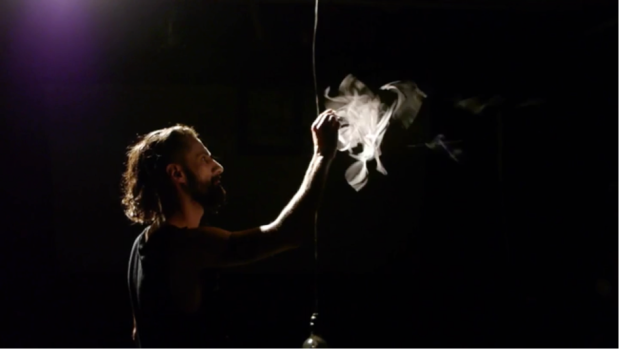 Dj Joro Boro popping a balloon filled with strips of cut-up text. Photo: Ross Karre
Dj Joro Boro popping a balloon filled with strips of cut-up text. Photo: Ross Karre
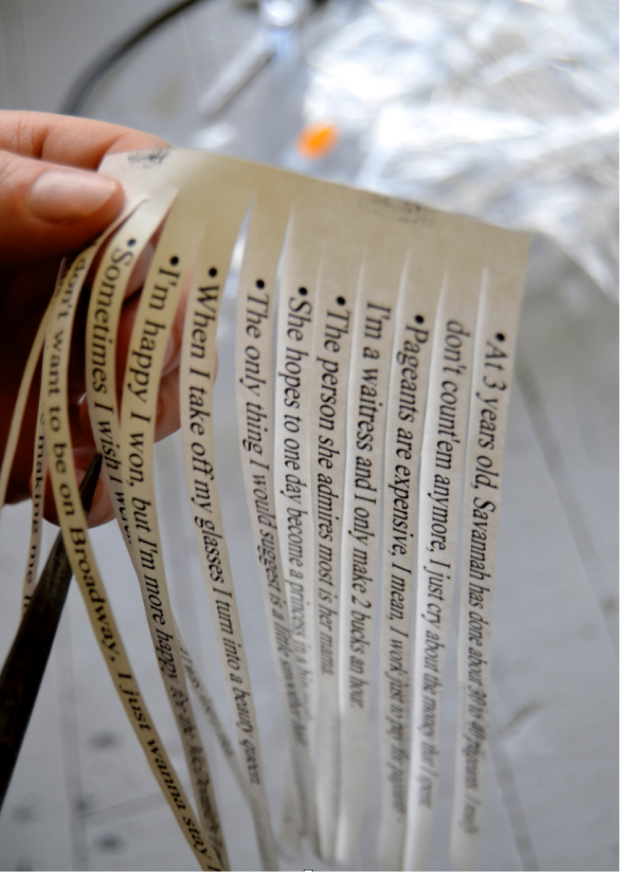 Preparing the manuscript Photo: Øystein Elle
Preparing the manuscript Photo: Øystein Elle
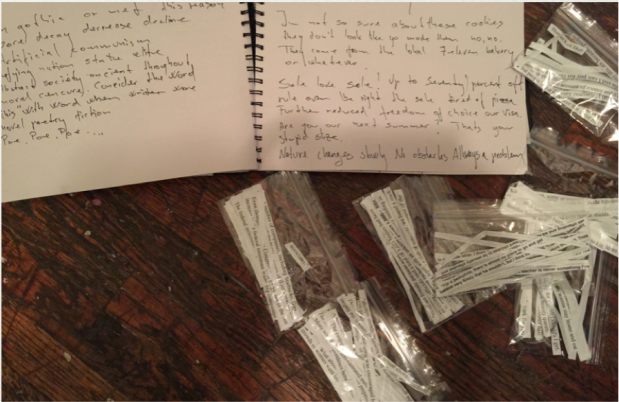 The manuscript of Decadence & Decay. Cut-ups sorted into labeled plastic bags. Photo: Øystein Elle
The manuscript of Decadence & Decay. Cut-ups sorted into labeled plastic bags. Photo: Øystein Elle
The performance of Decadence & Decay was structured around the “Seven Deadly Sins”. Every sin was written on a balloon, which was filled with one of the text bases as mentioned above. The show equalled seven scenes, with seven interludes. Each of the scenes has a specific duration, and were stopped by a beep. An interlude followed each scene and consisted of a voice-based performance of a particular text base after the balloon containing its text had been popped. The interlude lasts two minutes, and after the beep followed by the next scene. An opening scene and a closing scene framed the performance.

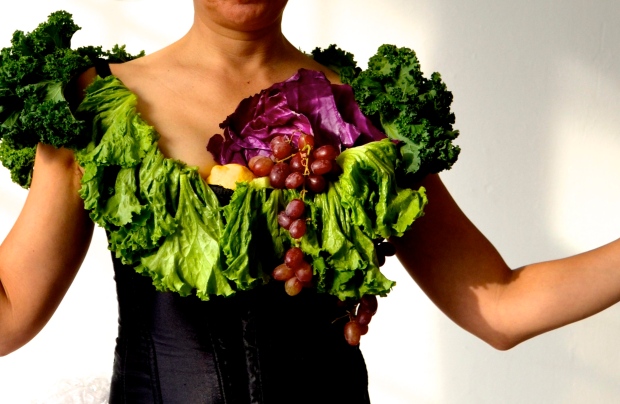 Testing edible materials as costumes. Brooklyn fall 2014. Photos: Corentin Leven
Testing edible materials as costumes. Brooklyn fall 2014. Photos: Corentin Leven
Visually we wanted to have references to both a baroque opulence and to a more contemporary-oriented pop, punk, club expressions. As a comment on a surplus society, and on a decadence related to food and contemporary Western use-and-dispose culture, we wanted to let the costumes partly consist of edible materials. We would be eating, spilling and making a mess with the food based material. Food we used in the performance and in the development phase was subsequently cooked and eaten.
The music
The music score of Decadence & Decay was developed through collaboration between the New York-based DJ/composer Joro Boro and myself. The music was partly developed simultaneously with the development of different physical scenes on the floor, and through joint songwriting sessions between Joro Boro and myself. Much of the material was performed by a loop-based DJ technique where vocal and instrumental pre-recorded sequences from both of us were put in a “pool” of musical material which he mixed live, in interaction with the physical action on stage. The following example is one of these bits of musical material that I made for the purpose of it to be treated in Joro Boro’s mix. In this recording I sing, play the violin, the flute, and the cello.
Other parts of the music score consist of re-arranged versions, with small fragments of baroque and renaissance songs and instrumental music such as the aria “Ombra mai fu” and “Lashia chio pianga” by G.F. Handel, and the romantic aria “O mio babbino caro” by G. Puccini. Examples of this can be heard in the video excerpts from the performance for camera of Decadence & Decay, which was recorded April 2015.
The full title of this project is “Decadence & Decay – A Neo-futuristic Baroque-trash Opera”. One could possibly argue that this play does not appear to be an opera; with Capto Musicae I have not intended to find alternative varieties of the opera form. That said, the opera form in a post-dramatic perspective might be an interesting path for further exploration and research. The term post-opera, or post-dramatic opera may seem relatively little considered and explored, without me to assert anything in this regard at this moment.
The following video shows excerpts from a performance of Decadence & Decay for camera. Recorded in Brooklyn, New York in April 2015.
Capto Musicae in the artistic Field
My artistic research, “Capto Musicae – Creating Sonic and Musical Theatre in a Contemporary Artistic Context” relates to a very rich diverse artistic field. Traditions and innovations in the field of post-dramatic theatre, baroque music, experimental writing, contemporary dance, visual arts and scenography, vocal techniques and aesthetics, opera and music composition are all areas informing the work of Capto Musicae. This has been both a challenge and a strength in my project. Central to my work is a desire both to involve traditions, and artistic currents, and also to build on them in order to create new artistic expressions.
There are many artists and artist groups I might mention as significant historical and contemporary performers and creators in the field, and in the traditions that I relate to. Many of these I have referred to earlier in this reflection paper, I will mention only a few more. In a Norwegian context it is natural to see my work in light of Tore Vagn Lid and his artistic project. His background includes work as a musician and composer, in addition to his position in dramaturgy and theater science. As a writer, lecturer and artistic director of “Transiteatret Bergen” he is a pioneer in Norway in the development of musical theater in a post-dramatic context. With “Transiteatret-Bergen” his work specializes in the exploration of the intersection between music and theater.[1] In addition, I find the work and the ideas of the composer Trond Reinholdsen, director of “The Norwegian Opra”, inspiring and to some extent akin to my own work. Reinholdsen asks: “What kind of music-theatrical results can one gain by removing the narrative of opera, or the voice, or the very scenic event?” (Reinholdsen 2014). Moreover, he examines how the opera format can gain from manifesting itself as a small resource-intensive form. He seeks a form of opera that relates to contemporary conceptual art, and which effectively can deal with and comment on society.
His work is related to my own in that he attempts to reinforce an expression through abstraction, and in his punk-related “DIY (Do-It-Yourself)” mentality through which he emerges as opera director, producer, composer, performer and stage designer. “DIY generally encompasses an ethic of self-sufficiency through the completion of tasks without the aid of a paid expert,” writes Kotrady, who continues with by quoting punk singer Tony Croasdale: “If you have a challenge, try to look at it through a lens of self-empowerment. There’s no reason to manufacture adversity, but realize that you have a lot of options and a lot of ways you can tackle the problem…You want to offer shows? You wanna see a band play? You know, just do it” (Kotrady 2016).
Reinholdsen`s work has an informing influence on me, in that he must be regarded as an artist who challenges opera as a form, and shatters conventions relating to format, content and execution. As such he is creating an opera form that removes or distorts the position of drama, of the traditional operatic singing style, and other significant markers of the art form. In this way his work with opera relates to the established tradition of post-dramatic theater.
There are many Norwegian artists who, to a larger or smaller degree, inform the field I work in, from their perspective in music, dance, song, theater; or from a mixture of disciplines. Silje Aker Johnsen is an example of the latter. In her expression she draws on traditions in baroque singing and the experimental history of Extended Vocal Techniques. She connects this with a physical improvisation and composition approach grounded in contemporary dance. Among singer-composers experimenting with singing aesthetics in combination with electronics there are a number of notable artists. Rather than listing them I mention only two: One is Kristin Norderval, who I highlight here again in part because she, as a performer and composer, draws on traditions and methods originating in Pauline Oliveros’ Deep Listening Technique. An artist who has had a great impact also on my work in recent years, Norderval often combines classical music traditions and vocal aesthetics with Extended Vocal Techniques and live electronic manipulation. The other is Maja Ratkje, an artist who is perhaps the greatest Norwegian exponent of extended vocal techniques, although her career as a composer and performer also spans a very wide range.
During my time as an artistic research fellow I have strengthened and significantly increased my network of international artists who, in various ways, directly inform my artistry. Many of these I have previously referred to, in my descriptions of collaborations and artistic dialogues. These are artists who, in various ways, form the fields my artistic oeuvre relates to. Among these artists are: Phil Minton (UK) through his practice as an improviser and performer of Extended Vocal Techniques; Robert M. Johanson (USA) of the Nature Theatre Of Oklahoma and his progressive work in creating groundbreaking forms of music theater. Sxip Shirey (USA) with his innovative practice as a performer and composer, where he crosses contemporary music and avant-garde musical aesthetics with singalong-friendly melodies and pumping beats; Yoshito Ohno (Japan) who is a carrier and a provider of first generation Butoh aesthetics, and one who, through his practice has shaped an unique method of dissemination for his artistic oeuvre, as such he influences new generations of theater and other artists. Both during the period with Capto Musica and through previously implemented projects I have collaborated with, and learned from, Linda Wise (France). She emerges as a distinct artist in the context in which I operate, both by virtue of her extensive work as a director and a vocal performer, and through her first-hand experience with Roy Hart and Alfred Wolfsohn’s extended voice practice, as former member of the Roy Hart Theatre.
 Phil Minton and Sxip Shirey brought together on stage for the first time on my festival «Sonic Harvest» October 2016. Photo Øystein Elle
Phil Minton and Sxip Shirey brought together on stage for the first time on my festival «Sonic Harvest» October 2016. Photo Øystein Elle
As I work across genres and disciplines, as a composer, singer, multi instrumentalist, physical performer, actor and director there are a vast number of artists, historically and in the contemporary field who inform how I work, in which directions I may look for, and which fields to explore. My diverse background is also my strength in relation to how I contribute to the artistic field in which I operate through my artistic research. By combining traditions from various artistic fields, and from a time-span of many centuries, I can show traditions in a new light, and contribute to new practices. For example in the baroque ensemble Ensemble 1704, which I am a part of as a countertenor singer and an actor, I have, in our recent performances, mixed Extended Vocal Techniques such as ‘ingressive distorted voice’ with traditional baroque singing, thus mixing experimental techniques related to the 20th and the 21st century’s avant-garde, with singing aesthetics associated with the legacy of the castrato singers. Through my research I am creatively and theoretically bringing into conversation elements of the historical voice across fields. I expand that field and create new areas through my working methods in order to expand the territory, as when I combine methods from Pauline Oliveros’ Deep Listening practice with experiments with noise, extended vocal aesthetics, baroque traditions, and a ruthless voice, collecting crumbs from ancient traditions of chant, throat singing and Nordic folk music to name only some.
Through my research I am making connections, between traditions and artists, across centuries, and across borders and continents. As in the aforementioned project in Japan where I invited to a collaboration between artists from three continents, and seemingly contradictory aesthetics. A project that connects avant-garde jazz and free improvised extended vocals, pop / rock, baroque, new wave, noise music and butoh dance. When staying in Tokyo I also gave an open workshop at Theatre Xcai on vocal improvisation and composition, and Extended Vocal Techniques, at a theatre strongly connected to the contemporary Japanese field of Butoh. I hope workshops like this, my guest performances there, and further collaborations with the artistic environment around Theater Xcai can be a part of an investigation in combining traditions from Butoh with the experimental tradition in vocal performance.
Throughout my period as an artistic research fellow I have been teaching voice, and regularly given workshops on improvisation, composition and vocal work, mainly at The Norwegian Theatre Academy, but also been teaching and advising student projects at The Danish National School of Performing Arts, and Rhythmic Music Conservatory, in Copenhagen, at workshops for art students on master level across disciplines, and open workshops, including my latest, “The Performative Voice” that I conducted in Tokyo. I let my students take part in my artistic research, both as early adopters, and as artists who I through my teaching can learn from.
My teaching is, and will continue to be, a significant part of my work as an artist. I see my practice as a teacher of historical, traditional methods and aesthetics in combination with fresh progressive research as a considerable contribution to a future artistic field.
Among the concepts I want to investigate further, and also more theoretically, is the concept of excess, and embellishment. Can the abundance of text, voices, sounds and materials, the polyphonic voices, and the heteroglossia (cf. Bakthin) that my work contains be structured or contextualized more precisely in a study of excess, and linked to the Baroque?
Another field I wish to examine and develop is notation, as I initially was planning to do through the project Capto Musicae. I wish in the future to work on researching a notation that can be read and understood across disciplines. Text scores work well in this matter, so do graphic scores. These usually provide a relatively open interpretation; what about when more complex theatrical or other cross-disciplinary compositions shall be notated.
During the three and a half years that have passed since I started Capto Musicae I have achieved a lot of my goals, and been able to delve into my artistic project. By sharpening my own artistic voice, and by having gained new insights and tools I have become eager to continue further research in the direction I have commenced through the period as an Artistic Research Fellow. Through Capto Musicae I have been able to connect and position my work and my research more strongly in the field, nationally and internationally. Since I ended the fellowship period I have initiated and conducted a multi-continental stage production, as well as currently being on different stages of development of several music-driven, or Composed Theatre, productions involving venues, and collaborative artists on three continents.
[1] ” Transiteatret-Bergen arbeider i skjæringspunktet mellom musikk og teater med utviklingen av et samtidsorientert og kritisk eksperimentelt teater.” http://www.transiteatret.com/bakom/om-transitteateret
Documentation of artistic work
Stuffed Camel – A Theater Sonata
Director/Composer/Concept/Idea: Øystein Elle
Dramaturge/Choreography: Robert M. Johanson
Assistant director: Anders Firing Aardal
Scenographer/Costume and light-designer: Johanna Dahlbäck and Jessica Tay
Co-creative performers: Desiree Vaksdal, Jonas Borgensgaard, Anders Firing Aardal, NikolineSpjelkavik, Marina Popovic, Victoria Røising, Anders Tougaard, Viola Tømte
Creative team: Øystein Elle, Robert Johanson, Anders Firing Aardal and Johanna Dahlbäck
Music: Øystein Elle, except: “The Schreber song” By Robert Johanson and the Codetta melody (If my complaints could passions move) by John Dowland (1563 – 1626)
Text: The manuscript is composed of material from various sources: Albert Camus “The Myth of Sisyphus” , William Gass “On Being Blue”, Daniel Paul Schreiber ” Memoirs of my nervous illness” , Fernando Pessoa “The Book of Disquiet” , Mathias Faldbakken, “Macht und Rebel” , Viktor Shklyovsky “A Hunt for Optimism”, The TV-Show “The Bachelor”, Radiolab, the actors´ Facebook-walls, and various public domain texts from the web. Some of the examples from Stuffed Camel in the above text, and all the stills images are from the first run of the performance, in October 2015. The following image contains the credit list for the 2015 edition.
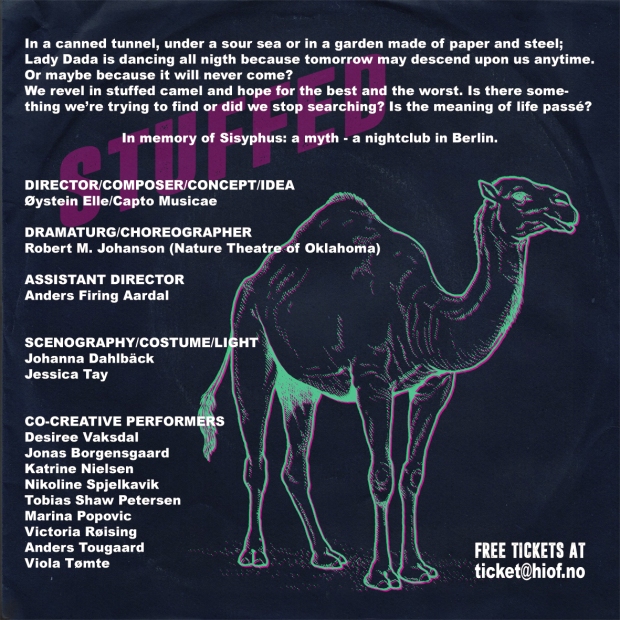
Territorium – A Visual Performance- Concert
A performance for camera, recorded at Norwegian Theatre Academy in November 2016.
Documentation from the opening of Territorium at “Tou Scene” in Stavanger, Norway, in March 2016.
Videostill from the performance of Territorium at the festival “The House and the Lights” in Fredrikstad, September 2016. Video: Matija Tatomirovic
Territorium is composed as a intermedial work, at the intersection between concert, installation, film and performance, by Øystein Elle in collaboration with Janne Hoem and Gunhild Mathea Olaussen. They open up a space defined by fragments of objects, pine needles, soil and feathers, organized in circular formations. As a volatile mandala of tracks, collections of items, relics, materials – as a plotted territory. Centrally located in the room is a sculptural stringed instrument of steel and wood that surrounds the performer and can be seen as his extended mouthpiece and inner territory. The text base for the performance is Elles own text, language like sounds derived from memories and mental images, and the Norse poem Skirnesmål, which was also the project’s starting point. Electro-acoustic sound from the instrumental sculpture, along with Elles voice is performed and live-processed throughout the performance. The stage is enclosed by four black projection surfaces where an intergrated film is played of, throughout the show. Whereas the film may possess a more concrete external action, the present performer carries an expression of an inner action. As exterior and interior.
Idea, initiator, concept, music, and performer:
Øystein Elle
Video, directing and concept:
Janne Hoem and Øystein Elle.
Set designer:
Gunhild Mathea Olaussen.
REFERENCES
Allan, Kenneth R. 2011. “Metamorphosis in 391: A Cryptographic Collaboration by Francis Picabia, Man Ray, and Erik Satie.” www.academia.edu. Accessed 23 April 2017.
http://www.academia.edu/4130505/
Bakhtin, Mikhail. 1984. “Problems of Dostoevsky´s Politics.” In Theory and History of Literature, Volume 8, edited and translated by Caryl Emerson. Minnesota: University of Minnesota Press.
Bellows, Henry Adams, translator. 2004. The Poetic Edda: The Mythological Poems. Mineola, New York: Dover Publications.
Bergmark, Johannes. 1991. “Butoh – Revolt of the Flesh in Japan and a Surrealist Way to Move.” Mannen på gatan. http://www.surrealistgruppen.org/bergmark/butoh.html Accessed December 2. 2016.
Breda, Sonja. 2012. “The Paradox of the Castrato”. St. Mary´s Academy. Young Historians Conference, 26 April 2012.
Burroughs, William S. and Brion Gysin. 1978. The Third Mind. New York: Viking Press.
Cage, John. 1973. “Sixty-two Mesostics re Merce Cunningham”. M: Writings ´67 – ´72. Hanover: Wesleyan University Press.
Camus, Albert. 1991 The Myth of Sisyphus and Other Essays. New York: Vintage.
Carlson, Marvin. 2015 “Postdramatic Theatre and Postdramatic Performance” New York: The City University of New York. http://www.scielo.br/scielo.php?script=sci_arttext&pid=S2237- 26602015000300577 Accessed May 1. 2017
Chandler, Daniel. 1995. Tbe Act of Writing : A Media Theory Approach. Aberystwyth : University of Wales.
Clover, Carol J. 1993. “Regardless of sex: men, women, and power in early Northern Europe”. Representations 44 : Fall 1993. The Medieval Academy of America.
Crump, Melanie Austin. 2008 When words are not enough: Tracing the devellopment of extended vocal techniques in twentieth-century America. Dissertation. The University of North Carolina Greensboro: Greensboro.
Armand D’Angour. 2013 “How did ancient Greek music sound?” http://www.bbc.com/news/business-24611454 Accessed May 13. 2017.
Duncan, Michelle. 2004. “The Operatic Scandal of the Singing Body: Voice, Presence, Performativity”. Cambridge Opera Journal : vol. 16, no. 3.
Elle, Øystein. 2016. “A chance to sing”. Nesoddtangen: Unpublished score.
Elle, Øystein. 2014. “Afal.” Nesoddtangen: Unpublished poem,
Elle, Øystein. 2013. “Omlingen sangle”. New York: Unpublished poem.
Elle, Øystein. 2016. “Remake of Tristan Tzara”. Fredrikstad: Unpublished poem.
Gass, William H. 1976. On Being Blue: A Philosophical Inquiry. New York: New York Review of Books.
Gomringer, Eugen. 1954. “Silencio”. http://www.poetrybeyondtext.org/concrete-poetry.html Accessed May 1. 2017
Goode Daniel. 2011. Conceptual, Verbal, and Graphic Scores. https://danielgoode.com/2011/09/15/conceptual-verbal-and-graphic-scores/ Accessed May 3. 2017.
Hall, Mitchell K. (2014) The Emergence of Rock and Roll: Music and the Rise of American Youth Culture. New York : Routledge, Taylor & Francis Group
Hegarty, Paul. 2007. Noise/Music: A History. New York: Bloomsbury Academic.
Jowitt, Deborah, editor. 2011. Meredith Monk (Art + Performance). Baltimore: PAJ Publications. The John Hopkins University Press.
Jung, C.G. 1981. The Archetypes and The Collective Unconscious (Collected Works of C.G. Jung Volume 9 Part 1). Princeton, N.J.: Princeton University Press.
Kendrick, Lynn and David Roesner, eds.. 2011. Theatre Noise: The Sound of Performance. Newcastle: Cambridge Scholars Publishing.
Kimbrough, Andrew McComb. 2002. “The Sound of meaning: Theories of Voice in Twentieth-Century Thought and Performance” PhD diss, Louisiana State University and Agricultural & Mechanical College.
Kolocotroni, Vassiliki, Jane Goldman, and Olga Taxidou, eds. 1999. Modernism: An Anthology of Sources & Documents. Chicago : University of Chicago Press.
Koons, Ryan. 2015. “Through the Lens of a Baroque Opera: Gender/Sexuality Then and Now.” Ethnomusicology Review Volume 20 (2015). http://ethnomusicologyreview.ucla.edu/ content/through-lens-baroque-opera- gendersexuality-then-and-now
Kotrady, Patricia Ann. 2016. “Consuming Authenticity: Deconstructing “Do-It-Yourself” Punk Rock Ethics in Philadelphia.” Honors Thesis, Dickinson College.
Krüger, Ida Amalie. 2016. “Honour, Shame and Gender. Norse goods relation to the Norse communities and social norm.” MA thesis, NTNU.
Kumar, Nitin. 2000. “Mandala – Sacred Geometry in Buddhist Art” Exotic India http://www.exoticindiaart.com/article/mandala/ Accessed 15 November 2016.
Lehman Hans-Thies. 2006. “Postdramatic Theatre” New York. Routledge.
Lely, John and James Saunders. 2012. Word Events: Perspectives on Verbal Notation. New York: Bloomsbury Academic.
Lewis, Pericles. 2007. Cambridge Introduction to Modernism. Cambridge: Cambridge University Press.
Malzacher, Florian. 2012. “Previously on Nature Theater of Oklahoma… : Kelly Copper and
Pavol Liska´s Theatrical Game with Control and Failure”. www.academia.edu. Accessed December 5. 2017. http://www.academia.edu/5044900/Previously_on_Nature_Theater_of_Oklahoma
Meier, Julia. 2008. “Diamanda Galás: Defining the Space In-Between.” American Studies as
Media Studies. Eds. Frank Kelleter and Daniel Stein. American Studies – Monograph Series, Vol. 167. Heidelberg: Winter 2008.
Morgenstern, Christian. 1905. “Fishes Naghtgesang”. Please see http://visual- poetry.tumblr.com/post/50404252219/fisches-nachtgesangfishs-night-song-by
Nesari, Ali Jamali. 2015. “Dialogism versus Monologism: A Bakhtinian Approach to Teaching”. Procedia – Social and Behavioral Sciences Volume 205 (9 October 2015): 642-7.
Neumann, Peder Holst. 1973. “Morgensterns Galgenlieder als poetologische Modelle betrachtet”. Sprachkunst 4. 1973: 61
Oliveros, Pauline. 1997. “A song for Magrit”. Antology of Text Scores .Deep Listening Publications 2013: 27-28
Picabia, Francis. 1924. Dadaist magazine Number 17: 3.
Plimpton, George, ed. 1967. Writers at Work: 3rd Series: The “Paris Review” Interviews. New York: Viking Press
Rebstock, Matthias and David Roesner, ed. 2012. “Composed Theatre” Bristol/Chicago: Intellect.
Robertson-Kirkland, Brianna E. 2014. “The Silencing of Bel Canto”. eSharp : Issue 21. http://www.gla.ac.uk/media/media_307347_en.pdf
Rome, Amy. 2007. “The Voice Embodied: A Practice-based Investigation through the Praxes of Noah Pikes, Enrique, Pardo, and Linda Wise.” PhD diss. University of Central Lancashire.
Schopf, Fiona Jane. Editor. 2015 Music on Stage. Cambridge: Cambridge Scholars Publishing.
Schwitters, Kurt. 1922-32. “Ursonate”. Accessed on May 1. 2017 http://www.medienkunstnetz.de/works/ ursonate/
Sheppard, Tim 2003 – 2012. http://www.timsheppard.co.uk/story/dir/traditions/index.html Accessed on May 13. 2017
Skerl, Jennie. 1986. William S. Borroughs. Woodbridge: Twayne Publishers.
Steinsland, Gro. 1991. “Sacred weddings and Norse royal ideology; an analysis of hierogami myth in Skírnismál, Ynglingatal, Háleygjatal and Hyndluljod.” PhD diss., University of Oslo.
Symonds, Dominic and Pamela Karantonis. 2013. The Legacy of Opera: Reading Music Theatre as Experience and Performance (Themes in Theatre) Amsterdam: Rodopi
Sørensen, Preben Meulengracht. 1983 The unmanly man: Concepts of sexual defamation. Odense: Odense University press
Tzara, Tristan. 1918. “Dada Manifesto: 23 March 1918”. 391.org archive. http://391.org/manifestos/1918-dada-manifesto-tristan- tzara.html#.WPx9dSN96it Accessed September 5. 2016
Verstraete, P. M. G. (2009). The frequency of imagination : auditory distress and aurality in contemporary music theatre. PhD Thesis, Amsterdam
Weir, William. 2011 “A Brief History of Singing in Invented Languages” http://www.slate.com/blogs/browbeat/2011/11/29/invented_languages_in_music_a_br ief_history.html Accessed May 14. 2017




